


A FOODIE INFLUENCER’S IMPACT | NOVAQUEST’S STRATEGY | RALEIGH’S CBD SEEKS A REVIVAL







A FOODIE INFLUENCER’S IMPACT | NOVAQUEST’S STRATEGY | RALEIGH’S CBD SEEKS A REVIVAL






Rick Hendrick’s auto dealership group takes the checkered flag in our annual private company ranking.





4 UP FRONT
CEO Mary Jo Cagle says Cone Health will be a distinctive force in making N.C. healthcare more affordable.
A Charlotte influencer’s clout with diners; Is downtown Raleigh rebounding?; Fayetteville State University plots a turnaround plan; Why Giselle Bündchen loves Transylvania County; Natron Energy electrifies eastern N.C.
80 PROJECT PLANS
An Olympic Games in North Carolina? Dreamers are hoping it can happen, aided by state investments that have shown an unclear payoff.


30 ROUNDTABLE: CHARLOTTE
Charlotte has proven credentials as a vital, livable global business center, local business and civic leaders agree.
64
North Carolina’s heart and cancer centers are on the cutting edge, and patients reap the benefits.
70
From certificates to diplomas, N.C. colleges and universities offer abundant possibilities to students.















CAR CRAZY
BY DAVID MILDENBERG


































Charlotte icon Rick Hendrick discusses building empires by pursuing his greatest passions.

BY PETE M. ANDERSON, DAVID MILDENBERG AND KEVIN ELLIS

















The annual list of the biggest closely held businesses that boost North Carolina’s economy.
BY MIKE MACMILLAN








It isn’t sexy, but the N.C. clinicalresearch industry keeps growing at a robust pace.
BY CHRIS ROUSH






Raleigh’s NovaQuest plays a pivotal role in boosting the state’s life sciences sector.








Thhe start of the school year always makes me consider the commitment to providing opportunities to society’s key assets, our kids and youth. Partisan e orts try to dumb down the issues, but it’s not simple stu . Fortunately, some folks do more than ponder, including the North Carolina Board of Science, Technology & Innovation, a unit of the N.C. Department of Commerce. For nine years, it has detailed how our state stacks up against other states on 42 measures of “innovation capacity.”
My colleague Ray Gronberg summed the report in our North Carolina Tribune newsletter: “We don’t have anything to get complacent about economically because we’re not doing as well as we may think.” at view matches the report’s overall tenor.
North Carolina’s GDP per capita, nearly $67,000 as of 2022, ranked 32nd nationally. e national average is about $77,600, and we’re trailing Georgia, Tennessee and Virginia. e latter state bene ts from massive federal outlays, but surely we can match the Peach and Volunteer states?
e report contends that a century of investing in infrastructure, institutions and human capital that fuels innovation has been insu cient to propel North Carolina’s income levels above the national average.
History teaches that North Carolina started from a tough spot, but made progress in the 1960s (lots of credit to Research Triangle Park) and the 1980s (both Reagan and Clinton administrations.)
But the state treaded water over the past 25 years, even as the Triangle and Charlotte metro areas became national business centers. Per capita income was 89% of the national average in 2022, versus 91% in 1998. Despite a fast-growing population, the state’s productive capacity and wage levels aren’t keeping pace overall, the report notes. e poverty rate remains above average.
e study implies that North Carolina essentially has two economies. One is the
Charlotte and Raleigh-Durham metro areas, which account for about half of state GDP, and more than half of the “innovation measures” such as R&D, venture capital and educational attainment. e other economy is everyone else.
What is happening to break this apparent malaise, outside of the two big metro areas? Most of our state’s most powerful lawmakers, who don’t live in Charlotte and Raleigh, are sticking to a tradition of emphasizing higher education. at includes pumping $500 million into the NCInnovation e ort aimed at promoting research outside the three key research campuses in Chapel Hill, Durham and Raleigh.
Overall, the state spends a higher percentage of state GDP on higher education than all but four states. Conversely, it spends a lesser percentage on K-12 education than all but one state, citing Census Bureau data.
At the K-12 level, key Republican lawmakers are focused on promoting school choice initiatives, such as providing statefunded vouchers for private school. (Because of a legislative dispute, they’ve botched getting money to about 55,000 parents who want help paying tuition this fall, as of press time.)
Leaders appear disinterested in boosting teacher salaries to match regional or national levels. For now, N.C. teacher pay ranks low, re ecting distrust for a system that still teaches 80% of our students.
But let’s close on a positive note. Using its most current analysis, the report says that North Carolina ranks 11th nationally for its overall innovation economy. Virginia is 12th and Georgia, 25th.
“Overall, North Carolina’s statewide innovation ecosystem is healthy, has improved since the early 2000s, and at a rate comparable to the U.S. as a whole,” the report concludes. e success just needs to spread out. ■

Contact David Mildenberg at dmildenberg@businessnc.com.

PUBLISHER Ben Kinney bkinney@businessnc.com
EDITOR David Mildenberg dmildenberg@businessnc.com
MANAGING EDITOR Kevin Ellis kellis@businessnc.com
EXECUTIVE EDITOR, DIGITAL Chris Roush croush@businessnc.com
ASSOCIATE EDITOR Cathy Martin cmartin@businessnc.com
CONTRIBUTING WRITERS
Pete M. Anderson, Ray Gronberg, Michael MacMillan, Michael J. Solender
CREATIVE DIRECTOR Cathy Swaney cswaney@businessnc.com
GRAPHIC DESIGNER Pam Fernandez pfernandez@businessnc.com
MARKETING COORDINATOR Jennifer Ware jware@businessnc.com
ADVERTISING SALES
ACCOUNT DIRECTOR Melanie Weaver Lynch, eastern N.C. 919-855-9380 mweaver@businessnc.com
ACCOUNT MANAGER AND AUDIENCE DEVELOPMENT SPECIALIST Scott Leonard, western N.C. 704-996-6426 sleonard@businessnc.com
CIRCULATION: 818-286-3106
EDITORIAL: 704-523-6987
REPRINTS: circulation@businessnc.com
OWNERS Jack Andrews, Frank Daniels III, David Woronoff, in memoriam Frank Daniels Jr.
PUBLISHED BY Old North State Magazines LLC
PRESIDENT David Woronoff BUSINESSNC.COM








Cone Health CEO Mary Jo Cagle joined High Point University President Nido Qubein in the Power List interview, a partnership for discussion with some of the state’s most influential leaders. Business North Carolina’s annual Power List publication spotlights the state’s powerbrokers.
Mary Jo, your life has been extraordinary. You are the first woman and first physician to be the CEO of Cone Health. That’s got to make you feel really proud.
Well, I’m delighted to have been asked. It was really a big honor and it’s a big job. So there are lots of challenges, but lots of rewards as well.
Health care touches every one of us. What would you say is the biggest challenge you have in running Cone Health?
One of the biggest challenges that we face right now are the changes in the workforce during the pandemic. We had many employees who decided
Cagle is a Jasper, Alabama, native who knew from an early age that she wanted to be a doctor. She earned bachelor’s and medical degrees at the University of Alabama. She practiced as an obstetrician and spent much of her career in Greenville, South Carolina, before joining Greensborobased Cone Health as chief medical officer in 2013. She became CEO in 2021 and now leads more than 13,000 employees. This interview occurred before Cone announced in June it was being sold to Kaiser Permanente’s Risant Health startup. Comments were edited for brevity and clarity.
to retire. We had the phenomenon of the travel nurse who decided to move to different parts of the country and work. And we had to face how the workforce was changing, which created shortages. We had to approach how we were going to supply enough nurses, enough pharmacy technologists and laboratory technologists. Practically every organization had to deal with people either being sick or wanting to work remotely or work two or three days a week.
The hospital part of your business demands people being there, taking care of patients 24-7. How did you deal with that challenge?
We had to be very creative. Certainly we had to go out and have contracts with some of these traveling nurses as well as contract folks for our laboratory, and other areas as well. But now we began to say, perhaps we need to provide a different way for our team to work where it is possible.
We’ve allowed some of our staff to work remotely in areas that are nonpatient-facing, including backroom operations, HR and finance. We’ve also allowed greater flexibility and scheduling for our nurses. We’ve gone to some nurses who retired early and said, would you be interested in working 20 hours? We have to be innovative and flexible. We found more people who were willing to come and work with us as long as we’re more flexible with them.
Running the patient to payment cycle, the security, the maintenance – all of that strikes me as very complex. Multiply that with how you get paid, how you run your organization and so on. Is there a hope down the road that we can make this simpler and easier?
I do believe there’s hope. I don’t believe it will be easy. It will require many of us working together. But I do think there’s a better way coming. For the past 12 years, we’ve been working on what we call value-based health care.
Now, that’s an easy term to say, but harder to understand. We believe there is a way that we can increase the quality and safety of your care and decrease the cost and have you pay your premium once a year. And for us to take some of the risk.
As a health system, if we lower your cost, you do better also. With our goal of seeing you in a doctor’s office and keeping you healthy, the insurance company does better, and we as a health system do better. All of us have lower costs.
If we keep you out of the hospital and the emergency room and everybody stays healthier, the payers are not paying big hospital bills. Because we’re at risk and we have said we’re going to lower the cost of care, if we don’t lower the cost, we’ll pay a penalty.
Pay a penalty to whom?
Let’s say it’s Blue Cross Blue Shield, we’ll pay a penalty to them because we went over the limit of care. But if we lower the cost of care and we create savings, then we split the savings.
It’s a win-win for everyone because we saved people money. Ultimately, that ought to decrease what people are paying to have insurance. We’ve been able to prove over the last decade that our physicians and our health system working together can lower the cost of care and decrease the number of times people are admitted to the hospital.
We believe this can work and it’s time to scale it to more people.
Help me understand, as a layman in simple terms, why is health care so complex?
Part of the reason it is so complex is we built a system that is unnecessarily complex. Sometimes you get the results of the system that you’ve built.
There are all of these negotiations behind the scenes that are required to be confidential by law between the hospital and the insurance company. And the contracts are hundreds of pages long. Diagnoses by diagnoses, saying what will be paid. And then there’s the negotiations between the pharmacies and the hospital and the insurers that determines how much they’re going to charge for each drug. So you begin to see the layers of complexity that go into the billing. It would be very, very different if the patient just said, I’m going to pay the bill and we’ve removed that intermediary payer.
Can they afford it? If someone is making $40,000 a year, and they have to go have some kind of an operation, it can be thousands of dollars.
I would suggest that the cost would come down because part of the cost of the health system is there’s a whole department that does nothing but process bills from those payers, which adds another level of costs.
Is there a way to improve it? I think there is. Health systems like Cone Health have an obligation to lower our costs. Year over year, we’ve been removing cost from our system. We’ve been using lean processes, which manufacturers have been using for decades.
Last year, we removed $100 million worth of cost from our system year over year. But it requires intentional focus and a new way of doing things. And I do believe that we’re going to partner with the payers and to be at risk to intentionally lower the cost?
The payers want to make money, right? Are they really motivated to do that?
This week I had the opportunity to have breakfast with one of the CEOs of one of the payers. While we don’t agree on everything, we agree that ultimately our goal is the same: to provide great care at a better price. So I do think that if we could
focus on the things we have in common, the goals that we want to reach together rather than our differences, that we could get there. When there’s a will, there’s a way.
What is the most difficult part of your job?
I believe everything I do is through relationships with people. The pace of change today is faster than it’s ever been. Probably the most important thing I do is work with people to help them through the pace of change, to help them see and accept it, and to have a vision of the future and where they fit in it.
If people are experts at the way things are today, the idea of changing to a future where they have to give up their current expertise is not very comfortable. Letting go of that to go to a future that is somewhat unknown, where I will no longer be the expert, is quite daunting and difficult.
A big part of my job is to help people see a vision of the future where it’s OK to take an appropriate, calculated risk to move into the future.
What would you say to someone on a college campus who wants to do well in life?
Never give up on your dreams. Find people who can mentor you and encourage you. I was very fortunate as a 3-year old little girl to audaciously tell my family doctor, Dr. Carey Gwin in Jasper, Alabama, I want to be a doctor like you when I grow up. I grew up in a little town where if you made the honor roll, your name was in the paper, and Dr. Gwin would cut that out of the paper and send it to me and say, ‘You’re doing all the right things.’
When I was valedictorian of the high school, he cut it out and sent it to me. What a simple thing. What a very great impact. I would say, not only to young people, but to all adults, that you can have a huge impact by doing simple things.
I think what you’re saying is we all need heroes, models and mentors in our life. We need people who plan and see greatness. Work hard. Keep at it. Don’t say I can’t.
So speak out loud your dream. Go ahead. Speak it into existence and understand that it does take hard work and perseverance. Surround yourself with other people who’ve succeeded.
I also think I really believe in reading books about successful people. Dr. Gwin told my mother, go get this girl a library card. I read the biographies of all kinds of successful people, and it’s still a habit that I have. And I would really encourage young people to find some heroes and understand how they did it.
I’ve seen you in many settings where often you’re the only female in a world that’s dominated by male CEOs. I’ve also seen you stand tall and speak your piece with confidence and conviction. So you’re hopeful about health care and its delivery to more people through more affordable systems?
I am. I look at the young people who are still going into health care and people who are dedicated and passionate about making certain that we provide good health care to everyone, regardless of their color or their religion in a socially inclusive society. That gives me hope as long as we have the next generation who are called to serve. ■





With school back in session at North Carolina’s colleges and universities, alumni and donor relations activities are in full swing and year-end fundraising efforts are fast approaching for nonprofits of all types. And as summer turns to fall, nonprofit institutional investors are navigating their own season of change in the form of portfolio and risk management complexities inherent in today’s environment.
“As nonprofit organizations, including colleges and universities, continue to be tasked to do more with less against the backdrop of inflation and economic uncertainty, PNC’s support for these institutional investors is rooted in delivering solutions that are innovative, efficient and customizable,” says Raleigh-based Barb Harsha, PNC Institutional Asset Management® market leader for the Carolinas.
Bringing additional depth to PNC Institutional Asset Management’s local presence and commitment are the capabilities of such discipline-focused specialty groups as Nonprofit Solutions and Insurance Solutions, led nationally by Winston-Salem-based Henri Cancio-Fitzgerald and Charlottebased Wade Meadows, respectively.
This comprehensive scope of advice and solutions, says Harsha, allows the local PNC team of advisors and analysts to deliver on the full breadth of opportunities available to higher education and nonprofit financial decision makers. And no discussion these days is complete, she says, without addressing three ongoing trends in institutional asset management: Outsourced Chief Investment Officer (OCIO) services, planned giving and captive insurance companies.
At the most basic level, an OCIO model enables an organization to delegate responsibility for the day-to-day management of its investment program by shifting discretionary investment responsibility for some or all investment functions from the asset owner to an investment advisor, says Harsha.
As an alternative to in-house asset management and traditional consultant models, OCIO services can provide an effective vehicle for institutions looking to enhance their investment capabilities and gain fiduciary support, while allowing the organization to focus on the investment policy and oversee overall performance.






This is the thirty-third in a series of informative monthly articles for North Carolina businesses from PNC in collaboration with BUSINESS NORTH CAROLINA magazine.


“OCIO services are ultimately designed to help an organization reduce costs, better allocate resources, participate in more sophisticated investment strategies, take on greater agility and timeliness in their actions and more accurately report on results,” says Cancio-Fitzgerald. “As a result of PNC’s focus on scaling and growing this service in recent years, we have helped clients – including nonprofit organizations – realize cost savings and risk controls that were previously only available to much larger organizations.”
While a nonprofit’s primary focus is delivering on its mission – and raising the necessary funds to achieve that mission, a successful development office takes this focus one step further by incorporating gift planning and planned giving to advance or exceed fundraising goals, says Cancio-Fitzgerald. “A planned giving program targets funds that will benefit an organization for years to come,” he says. “It can be used as broadly as endowment-building or can be targeted to fund future projects.”



Barb Harsha
Establishing a planned giving program requires additional time and a strong acumen in administration, compliance, investment and donor relations. For many organizations, a planned giving program can begin as a reasonable in-house operation, but with growth and over time, the program can become burdensome as financial decision-makers balance day-to-day administration with managing relationships with this important donor set.
To help nonprofits address these challenges and maintain planned giving programs in a more passive manner, PNC Institutional Asset Management enables organizations to outsource the investment and back office functions of their planned giving program. “We also offer assistance with education, training and gift planning consultation to help organizations offer their donors a more thorough understanding of the organization’s charitable mission and articulate the many methods available to make an impact through gift planning and blended giving strategies,” says Cancio-Fitzgerald.







In recent years, a hardening commercial insurance market has generated increased interest in captive insurance companies, which function as direct insurers or reinsurers for an organization’s parent company or affiliates.
As the third-largest domicile for captive insurers in the U.S., North Carolina is known within the industry for its captivefriendly environment. Since the passage of the North Carolina Captive Insurance Act more than 10 years ago, the state has become home to more than 1,500 such licensed risk-bearing entities, according to the North Carolina Department of Insurance.
The potential benefits of a captive, says Harsha, include the ability to tailor coverage to the needs of the organization, better take advantage of often predictable insurance market cycles, offer creative risk solutions, provide coverage that the commercial markets do not and consolidate risk management.
“Typically, the primary reason for organizations, including nonprofits, to create a captive is to provide improved risk management, as captives can make financing risk more costeffective and ultimately reduce an organization’s total cost of risk,” explains Meadows. “As a platform for an organization’s risk management, captives also can help improve cash flow management and provide investment returns which, through
Weston Andress, Western Carolinas: (704) 643-5581
Jim Hansen, Eastern Carolinas: (919) 835-0135
proper captive management, can offer overall insurance premium cost savings.”
Because organizations have different needs, says Meadows, every captive should be structured differently. “Maximizing the benefits of a captive means understanding and responding to the various risk lines and concerns within the organization,” he says. Because a captive entity is subject to complex regulations, Meadows recommends that interested organizations conduct a feasibility study and analysis before making the decision to form a captive.
While the above-referenced strategies represent important considerations for nonprofit institutional investors in today’s market, Harsha is quick to note that each organization has its own unique set of opportunities and challenges to consider when it comes to managing assets, risks and fundraising.
“As a philanthropically minded and community-centric organization, we recognize the intrinsic value that the higher education ecosystem and nonprofit space create for the health of North Carolina’s economy and communities,” she says. “That reality is never far from our minds as we work alongside these organizations to deliver on their investment and risk management goals.”
These materials are furnished for the use of PNC Bank and its clients and do not constitute the provision of investment, legal, or tax advice to any person. They are not prepared with respect to the specific investment objectives, financial situation, or particular needs of any person. Use of these materials is dependent upon the judgment and analysis applied by duly authorized investment personnel who consider a client’s individual account circumstances. Persons reading these materials should consult with their PNC account representative regarding the appropriateness of investing in any securities or adopting any investment strategies discussed or recommended herein and should understand that statements regarding future prospects may not be realized. The information contained herein was obtained from sources deemed reliable. Such information is not guaranteed as to its accuracy, timeliness, or completeness by PNC. The information contained and the opinions expressed herein are subject to change without notice. Past performance is no guarantee of future results. Neither the information presented nor any opinion expressed herein constitutes an offer to buy or sell, nor a recommendation to buy or sell, any security or financial instrument. Accounts managed by PNC and its affiliates may take positions from time to time in securities recommended and followed by PNC affiliates. Securities are not bank deposits, nor are they backed or guaranteed by PNC or any of its affiliates, and are not issued by, insured by, guaranteed by, or obligations of the FDIC











By Michael J. Solender
Miranda Mounts knows her social media audience is hungry to experience Charlotte’s hottest restaurants.
Her marketing company, Where to Eat Charlotte, works with restaurant owners to increase awareness and drive tra c to their businesses.
“Every restaurant starts with a story or an idea,” she says. “We share a deeper dive into why the restaurant is what it is, and what makes every restaurant special. It’s not just dining out, it’s (making the) connection.”



Collaboration is key for Charlotte restaurateur Andre Lomeli, who has worked with Mounts for two years to promote his Mexican restaurants Mal Pan and El Malo. “We have an annual package of posts with Miranda,” he says, along with separate e orts to boost late-night or brunch specials. “ ey drive tra c. We see sales spike for up to a month a er the posts. It absolutely works for us.”

As of August, Mounts’ Instagram account, (@wheretoeatcharlotte) had more than 191,000 followers. Eager to connect with her audience, Charlotte restaurants such as Mal Pan, Yama Asian Fusion and Community Matters Cafe are paying for social media posts, videos, story bundles and promotions via the Instagram, Facebook and Tik Tok channels. Her features on openings, new o erings, specials and latest deals typically score thousands of engagements. ese likes, comments and shares are the coin-ofthe-realm for restaurateurs seeking diners with dollars to spend.



Originally from Columbus, Ohio, Mounts, 30, moved to North Carolina to play varsity volleyball at UNC Wilmington. A er earning a bachelor’s in communications and media studies, she worked in sales for a seafood wholesale company. She moved to Charlotte in 2018 and started a food blog for fun, re ecting her love for restaurants.
“About a year in and as my audience grew, restaurant owners began asking if I could do an exchange, if they could give me free food to do a post. My business has evolved from that.”
Mounts doesn’t view herself as a food critic, unlike dozens of others who cover North Carolina restaurants for media outlets or their own digital programs. Her limited liability corporation has expanded with a podcast that debuted in July;
a revamped website featuring curated restaurant guides and a periodic newsletter. She has tapped a consultant to help her with marketing, new products and pricing.
Of Instagram’s 104 million Instagram users, 10.2 million are considered in uencers, capable of swaying purchasing decisions and audience behavior, according to the In uencity research rm. at’s four times as many people with such in uence as in 2020, the group says.
Like many in uencers, Mounts’ most valued asset is probably the skill of re ecting her personality through colorful, creative posts. She o ers a plucky girl-next-door, wiser-sister vibe that appeals to women and men alike.
“Social media is integral to being successful as a restaurant,” says Corri Smith, owner of Charlotte-based Black Wednesday, a public relations and social media rm. “ ese are small businesses. ey don’t have huge budgets for billboards, automated websites or commercials on TV. ey rely on more organic forms of marketing, such as social media, online reviews and word of mouth.”
In uencers add value by “putting together directives, what to do, where to go, where to eat, what’s cool, what’s new,” she says. “People are looking for direction, they don’t know where to go, and (a recommendation) makes their lives easy. ere’s a big opportunity there for people that want to make other people’s lives easy.”
at’s especially true for the crowd in the 18-44 age range who make up 78% of Mounts’ audience. ey are most coveted by many restaurant owners because of their dining out habits. For diners belonging to Gen Z (born between 1997 and 2012), and the Millennial cadre born between 1981 and 1996, eating out is a frequent, planned-for expense. About 36% of the those cohorts plan to splurge on dining out, according to a McKinsey & Co. report.
Smith says in uencers tend to fall into three categories, with “micro-in uencers” having fewer than 10,000 followers and may get paid with a free meal as a trade. e next tier of as many as 40,000 followers seeks a combination of trade and payment, while those with bigger followings are most likely to charge fees for various services.
Fees are always negotiable and vary widely by service, product and in uencer. But Smith says a rule of thumb is a cost of about $11 per thousand followers. So someone with 100,000 followers might be able to charge Restaurant X more than $1,000 for an Instagram post.
A key selling point of social media is that sales data can help evaluate a campaign’s e ectiveness. But other metrics are less tied to immediate revenue returns and might focus on brand burnishing, for example. “ e launch of a seasonal menu or introducing a new promotion, we’re looking at












in uencers to have an ongoing relationship with restaurant clients,” Smith says.
Mounts says her fees are competitive, given her reach, engagement rate, and quality of work. “ ere’s an extensive process before we highlight a restaurant,” she says, noting she checks health department ratings, visits each restaurant and meets the owner to see if the business aligns with her standards and values. “We work with a variety of budgets and are exible with how we showcase our clients.”
It’s a larger mission for Mounts than just advising her followers where to eat. “ ere’s a deeper passion rooted in something a lot bigger, though. We’re highlighting stories,” she says. “ at’s a calling to me, it’s connecting these people to an experience, and of course to the food.” ■







































A $63 million College of Education building is among the projects helping revitalize Fayetteville State University. It is expected to open in 2026

Military appeal, summer courses, state lawmakers’ support and a popular restaurant signal a revitalized Fayetteville State University.



By David Mildenberg
Buying half of a strip shopping center near the Fayetteville State University campus that the school didn’t already own may be a relatively small real estate transaction. But the $5 million transaction signals the institution’s bigger ambitions.
A Chick- l-A is opening this month at the Bronco Midtown development, which since 2002 has housed a mix of o ce and retail tenants, including the Greater Fayetteville Chamber. Fayetteville State spent about $1 million on updates, a sliver of the $200 million in capital projects aimed at improving the second-oldest UNC System university, which dates to 1767.
“We’re very appreciative of the signi cant investment that is being made,” says Darrell Allison, who became chancellor in 2021 a er serving on the UNC System Board of Governors. “It’s already helping us turn the corner. We want to be an institution that sustains these gains and continues to be desirable and a ordable.”
Allison inherited one of the state’s most challenging higher education jobs. “We were last in student retention of the 16 campuses, last in graduation rates, and last in alumni giving,” he says.
Still, there’s a clear demand for the public university in the state’s h-largest city. Fayetteville State’s enrollment increased 16% between 2014 and 2023 to about 6,850,
including about 1,000 graduate students. Overall, UNC System enrollment gained 9% during the same period.
About a h of Fayetteville State’s students graduate within four years and a third within ve years, according to system statistics. at compares with a four-year graduation rate of 50% for the entire system, and a 65% ve-year rate.
Nobody likes that performance, though there’s plenty of history to explain some of the challenges. About half of Fayetteville State’s students are age 25 or older, compared with about 30% for the UNC System.
Fayetteville is among the system’s ve historically Black campuses, which have historically struggled to receive resources. It’s the last system campus to add a substantial recreation center, which Allison says has become an essential tool to recruit and retain students and faculty. Fayetteville State’s wellness center is slated to open in January 2026.
While a designated HBCU, nearly 40% of Fayetteville students are not Black. at compares with fewer than 15% at the state’s two largest HBCUs, N.C. A&T State and N.C. Central universities.
Fayetteville’s main economic driver is Fort Liberty, the largest U.S. military base that is located eight miles from the university campus. It has a transitory population with di erent needs than a traditional college campus.

To improve graduation and retention rates, Allison has stressed a ordability and convenience for a student population that di ers from most N.C. campuses. In 2022, Fayetteville State joined the state’s NC Promise program that limits tuition to $500 per credit hour for in-state undergraduate students.
Allison also has helped create a public-private fund that provides free tuition for military-a liated students. “We’ve seen a 25% increase in the number of military students since [2021] with about 33% of our nearly 7,000 students military-a liated. We lead the system by far in that category.”
Bee ng up summer programs has become a key agenda. Two-thirds of students took summer courses this year, a much higher percentage than the UNC System average. Incoming freshmen are promised 28 credithours of tuition-free summer courses,.most are o ered online, which Allison says is preferred by most students and instructors.
Emphasizing high-demand educational areas is essential, so Fayetteville State is bee ng up programs in cybersecurity, supply chain and construction management.
“Our leading question is whether our education is really worth it and how do we respond with an emphatic yes,” Allison says. “We know we have to be exible and change strategically to meet students where they are.” ■









By Chris Roush


Downtown Raleigh’s revitalization hinges on friendships, groceries, safety and Dix Park.
When Larry and Randall Miller’s children moved out of their Cary home, the couple decided they wanted to live in a more urban environment. So they moved into a 1,600-square-foot condominium in the Glenwood South neighborhood of downtown Raleigh. Now, they can walk to a Publix grocery story and their favorite restaurants.
“Cary was a good place to raise kids, but we wanted a place that was more walkable,” says Larry Miller. “We’ve met a lot of people and made a lot of friends. When we lived in Cary, we’d drive home at the end of the day and go into the garage and close the door and that was about it.”
Raleigh is looking for more people like the Millers. Over the past year, economic development boosters have implemented a plan to make the downtown more attractive for residents and visitors. Art and exercise equipment were added, along with signs directing people to the three big state museums near the state Capitol. ey also encouraged restaurants to add outdoor seating on Fayetteville Street, the city’s main drag.
“You have these beautiful wide sidewalks on Fayetteville with the pavers,” says City Council member Jonathan Melton, who lives downtown and rides his scooter or walks. “I think we have a real opportunity to recalibrate and reinvent that space.”
Now, the group is looking beyond Fayetteville Street. Talks are being held about creating pedestrian and biking paths between Dix Park and the downtown district, especially the convention center and hotels. at follows an April trip to Atlanta in which a group of city leaders saw the Georgia capital’s hugely successful Beltline network of public parks, trails, transit and a ordable housing projects along a historic 22-mile railroad corridor.



Connecting downtown to Dix Park is “one of the more strategic issues of Raleigh’s next phase,” says Dix Park CEO Janet Cowell, who is leaving that position in October and is running for mayor. City leaders and the nonpro t Dix Park Conservancy are redeveloping the former location of a state mental-health hospital that is a mile southeast of downtown.
Businesses and real estate developers are paying attention. In the rst quarter, 19 new businesses opened downtown, with ve closings. ere are more than 2,200 residential units (up from 786 units right before COVID started) and 410 hotel rooms under construction. A $387.5 million expansion of the Raleigh Convention Center will add 300,000 square feet when it’s completed in 2028.
In July, JLL Capital Markets raised $85 million of debt and equity nancing for the 252-unit Oldham & Worth, an apartment development located in downtown’s West End neighborhood. It’s the second phase of Kane Realty’s re-development of contractor Clancy & eys’ headquarters; the rst phase of Platform apartments is now leasing for $1,250 to $4,000 per month.
Meanwhile, CBRE has begun leasing retail space at e Creamery, a downtown mixed-use development slated to include the 306-unit, 37-story Highline Glenwood apartment building from developer Turnbridge Equities. It is expected to break ground early next year and would be Raleigh’s tallest building.
Like many center cities, Raleigh is ghting perceptions of too much crime and homelessness. e Downtown Raleigh Alliance hired two social workers two years ago to help homeless people nd shelters and permanent housing. It also pressed Raleigh police to increase patrols, resulting in a 22% decrease in crime in the past year, with burglaries down 70%.


David Meeker, who owns several downtown businesses and properties, says his State of Beer sandwich and beer shop has seen a 15% increase in sales since developer Trammell Crow opened its 400H apartment complex this past year. e 242-unit building is three blocks west of the state Capitol.
Still, the pandemic caused many workers to abandon downtown. “It felt like the comeback should have come quicker,” Meeker says. “ is year, downtown Raleigh feels di erent and more active.” In the downtown district, food and beverage sales have increased 7.9% this year, while hotel room revenue is up 6.7%.
Raleigh-based Kane Realty has added two downtown residential developments in the past ve years, says CEO Mike Smith. Both feature grocery stores, the aforementioned Publix at the Smoky Hollow development and a Weaver Street Market at Kane’s Dillon apartments. Kane is the developer of North Hills, the mixed-use district ve miles north of downtown that has attracted more than $1 billion of development over the past two decades.
“ e key to having residents and vibrant downtown communities is to have groceries,” Smith says. He predicts major growth in downtown Raleigh’s west side because of the Dix Park revitalization.
When Downtown Raleigh Alliance CEO Bill King rst saw the city a decade ago, it was considering whether to be a “big city or more of a town.” e reality is that Raleigh “is growing rapidly. And the issues are more complicated. We’re a big city now.”
About 5,400 people live in an area bounded north-south by Peace Street and Lenoir Street and east-west by East Street and West Street. Average rents have dropped to $1,807 from a high of $1,916 in early 2022 mainly because of increased supply.
DOWNTOWN RALEIGH RESIDENTIAL UNITS UNDER CONSTRUCTION:
King would like to see more minority- and women-owned businesses populating the district. Downtown businesses are 90% locally owned and 46% women-owned. Attracting life sciences companies and labs is another goal, similar to e orts that have proved successful in neighboring Durham and Chapel Hill.
e Alliance counted about 1.5 million unique downtown visits in the rst quarter, nearing their pre-COVID level of 1.6 million in the rst three months of 2019. Overall downtown storefront occupancy is about 84%, though it’s only about 70% on Fayetteville Street.
Connecting Dix Park to downtown is complicated by the four-lane Western Boulevard and some railroad tracks that make it challenging for pedestrians. Among the solutions being oated is a gondola or a pedestrian bridge covered with grass and trees.
“It ought to be connected,” says King, noting convention attendees would enjoy early morning walks or runs to the park. “We need to gure out how to get from here to there.” ■


Foreign companies seek growth in Transylvania County.

By Kevin Ellis
Gisele Bündchen’s face has graced more than 1,200 magazine covers in a decades-long career. She even out-earned her former husband, retired NFL quarterback Tom Brady, during his Super Bowlwinning years.
Last year, work brought Bündchen to Brevard in western North Carolina, far from the usual fashion hotspots where one might expect to see a supermodel. But the Brazlian, who now lives in Costa Rica, wasn’t there for a Versace photoshoot.
Bündchen had become a “wellness ambassador” for Gaia Herbs, one of an increasing number of biotech and life sciences companies that are making their headquarters in Transylvania County.
Bündchen’s visit explored how Gaia Herbs manages its 350-acre farm, where it grows between 30 and 40 di erent types of plants that make up about a quarter of its total botanical usage, says Brian Traylor, who joined Gaia Herbs in 2016 and has been its chief operations o cer since 2021.
“She wanted to come out to the farm and get her hands in the dirt,” he says.
Gaia Herbs started in western Massachusetts in 1987 and moved to Brevard in 1996. Founder and former CEO Ric Scalzo was drawn by the region’s biodiversity and favorable soil and climate conditions. Despite its long history, a former executive described the company as the “biggest secret” in the industry and an “incredibly quiet company.”
Bündchen’s star power has helped ignite social media buzz, bringing Gaia Herbs exposure on health-related programs along with name drops in news articles about Bündchen in publications ranging from People magazine to Harper’s Bazaar.


When the CBS TV show “Sunday Morning” featured Bündchen talking about “modeling, divorce and her true self,” part of the 8-minute segment showed Bündchen at the picturesque Gaia Herbs farm talking about her children liking the products, and her years as a customer, speci cally Gaia’s Black Elderberry Syrup in support of immune health.





“She’s a great ambassador for us,” says Traylor.
Gaia deserves credit for helping cement western North Carolina’s reputation in natural products, says Jonathan Snover, who heads the Asheville o ce of the Durham-based North Carolina Biotechnology Center.
A er starting with about 90 employees in North Carolina, Gaia Herbs now has about 250, with 100 at a distribution center in Mills River in neighboring Henderson County, says Traylor. Another 20 temporary agricultural workers stay for seven to eight months on visas during each growing season.
Gaia Herbs sells products nationally at Whole Foods, Sprouts and other retailers, while e-commerce is its fastest-growing segment and accounts for about as much as 45% of sales, Traylor says.
e private company declined to share nancial details except to say it is experiencing consistent annual growth. e global herbal supplements market grew 7.5% last year to $10.14 billion in 2022 to $10.91, according to Reportlinker.com, and is expected to expand to $14.8 billion by 2027.
Gaia Herbs is the old-timer of the cluster of companies. Two more recent entries, Pisgah Labs and Raybow USA, received $71 million in foreign investment from India and China for expansions, says Burton Hodges, executive director of the Transylvania Economic Alliance.
“Each one has its own story, but the fact that they’re all three in such a small town as Brevard is interesting,” says Snover.
It’s unclear why particular kinds of companies congregate in particular areas, he says. North Carolina has emerged as one of the most signi cant agriculture-tech hubs in the U.S., but not all areas of the state are equal, he says. Some have built-in advantages, such as Raleigh, which includes the Research Triangle Park.
“ e ‘R’ in RTP is for research and the Triangle references three major research universities (NC State University, Duke University and UNC Chapel Hill),” says Snover. “ ose are assets more rural communities in North Carolina, and frankly in most other states, cannot duplicate.”
But communities can play to their strengths. “ at’s how our region has garnered the life science companies that are already here,” he says.
“From my perspective, the answer would be that some people just want to live in a beautiful place and start a company,” says Snover. Mountainous Transylvania County, which is famous for its waterfalls, certainly quali es. “And, you know, I want to nd more of those people.” ■


While they don’t have Gisele Bündchen out ont, Transylvania County’s Pisgah Labs and Raybow have strong stories. Both were bought by much larger foreign businesses. Both have expansion plans underway.
Ipca Laboratories, based in Mumbai, India, paid about $9.6 million for Pisgah Labs in 2018. Pisgah Labs started in1981 and makes active pharmaceutical ingredients for other drugmakers. Pisgah had seven employees at the time of the sale, says Dani Bradley, a 27-year company veteran and now the Pisgah Labs site manager for Ipca.


Where previous owners located the company on a 125acre site, Ipca has helped the company grow, says Bradley. In 2022, Pisgah Labs announced a $55 million investment to expand, promising 57 new jobs with average annual salaries of almost $60,000. e company has grown from 28 to 45 employees since then, and should have more than 100 in the next four to ve years, Bradley says. Pisgah Labs will be able to make sterile injectables and liquid/oral pharmaceuticals a er the expansion.
“ ere’s really nothing else like us in the area that does what we do,” she says. Blue Ridge Community College helps with worker training, as most jobs at the company don’t require a college degree.
China-based Jiuzhou Pharma bought PharmAgra Labs in 2019 from North Carolina entrepreneurs Peter Newsome and the late Roger Frisbee for a reported $16 million, and renamed it Raybow USA. e company had about 30 employees, including about a half who hold doctoral degrees.
In 2021, Raybow announced a $15.8 million investment to create 74 positions over the next ve years. Raybow provides contract research and development in organic and medicinal chemistry. ■



















By Kevin Ellis
dgecombe County, which hasn’t had an unemployment rate lower than 5% since 1990, has attracted a $1.4 billion, 1,062 job project that is raising hopes for economic rebirth in northeast North Carolina.
ESanta Clara, California-based Natron Energy evaluated more than 70 sites across nine states before selecting the 2,187-acre Kingsboro megasite, about nine miles east of downtown Rocky Mount. Natron will occupy about a h of the site, or about 437 acres.
Its proposed 1.2-million-square-feet facility would build sodiumion batteries, with production launching in 2028. Average salaries are expected to be nearly $64,100 annually, which is 40% more than the county average of about $43,200.
Natron picked Edgecombe County over sites in South Carolina and Tennessee because of incentives, operating costs, available talent pool and supply chain considerations.
“ is is the best place for our new home. We choose to build here, we choose to grow here for decades to come,” says Natron co-CEO Colin Wessells, who founded the company in 2012 as a Stanford University graduate student.
State and local incentives total about $186 million over the next 12 years, including nearly $130 million in tax subsidies from the county. Most of the money won’t transfer to Natron until they hit investment and job targets.
While Edgecombe’s unemployment rate was 6.1% in June, North Carolina’s overall rate hasn’t exceeded 4% since December 2021.
Edgecombe started acquiring land for the Kingsboro megasite in the early 2000s, according to the Economic Development Partnership of North Carolina. In 2017, Chinese-owned Triangle Tyre announced plans for an 800-employee tire-making operation, but canceled the project in 2022.
About 345,000 potential workers live within an hour’s commuting distance of the site, which is about 15 miles from Interstate 95, says Rocky Mount Mayor Sandy Roberson. Consultants hired by the
EDPNC ranked the site No. 1 in the state for readiness. No other site considered by Natron was comparable, Wessells says.
“It’s sort of our eld of dreams,” says Roberson. “It’s not just a piece of land, it’s a gateway to opportunity.”
Natron’s announcement builds on North Carolina’s reputation as a “battery belt” leader. e biggest project is Toyota Battery Manufacturing’s planned $14 billion complex, expected to eventually employ more than 5,000 in Randolph County. In Durham, Kempower opened its EV charging manufacturing headquarters in June and has 120 employees, with plans to hire 200 more.
Natron will manufacture batteries for various industrial, datacenter and military uses and EV fast-charging stations. Its technology is distinct from the lithium-ion batteries used in most electric vehicles developed by Toyota and others.
Natron says its batteries are non- ammable and do not require lithium, cobalt, copper or nickel, most of which comes from outside the U.S. Instead, sodium-ion batteries rely on a domestic supply chain, including aluminum, iron, manganese and sodium electrolyte.
Last year, the company raised $318 million from private investors, including United Airlines, which plans to use the batteries for its airport operations. In 2020, the U.S. Department of Energy granted Natron about $20 million to support “potentially disruptive new technologies.”
e Edgecombe site will expand Natron’s current production capacity by 40 times. It opened a much smaller manufacturing facility in Holland, Michigan earlier this year.
“You couldn’t draw up any better company or design anything better when you think about the need for electri cation. is is a safe product that is for the most part U.S.-based,” says Bob Pike, CEO of Carolinas Gateway Partnership, which promotes Nash and Edgecombe counties and the cities of Rocky Mount and Tarboro. “It is a paradigm shi in terms of a disruptive product. We have a tremendous asset with Natron being our catalyst.” ■


ServiceTrade, a leading provider of software solutions for commercial service contractors, is excited to announce the appointment of William Chaney as its new Chief Executive Officer. Chaney brings a wealth of experience and a proven track record of leadership in SaaS software, specifically for field service contractors. With a career spanning over twenty-five years, Chaney is well-equipped to lead ServiceTrade into its next growth phase. With software solutions tailored to fire protection and mechanical contractors’ unique needs, deep customer relationships, and a unique combination of industry and SaaS technology expertise, ServiceTrade is poised for continued success and industry-leading growth.




Goodwyn Mills Cawood (GMC) has expanded its landscape architecture services to the Carolinas with the addition of Tripp Barrineau as vice president of landscape architecture in the firm’s Charlotte office. His almost two-decade career includes working with municipalities, architects and private developers to achieve their vision. He has a passion for preserving the natural environment in his planning of greenways, streetscapes, trails, creek restoration, environmental improvements and more.

BNC’s Movers + Shakers offers an exciting way to announce executive hires, promotions, board appointments, special announcements and philanthropic activities Your news will be published to 17,000+ emails of top executives throughout NC, seen on Business North Carolina’s website, and printed in our magazine.
Premium Listing: For $325, submitted premium Movers + Shakers listings will appear online and in our Daily Digest newsletter. Submissions will also appear in the next published issue of Business North Carolina.
Standard Listing: For $125, submitted standard Movers + Shakers listings will appear online and in our Daily Digest newsletter





by Melody King and Bill Durr
One's ownership in a closely held business (often a family business) may be affected by a separation or divorce. In many situations, the business will be joined as a party in an equitable distribution lawsuit (the term used in North Carolina for a lawsuit involving the division of marital property after a married couple separates). Once the business is a party to the lawsuit, it might need its own attorney – separate from the attorney for the spouse with the ownership interest.
There are three essential steps in any equitable distribution lawsuit: classification, valuation, and distribution.
Classification
Initially, the Court/attorneys must determine what property might be subject to distribution. Property is a very broad term and includes LLC membership interests and shares in any corporation.
"Marital property" means all real and personal property acquired by either spouse or both spouses during the marriage and before the date of separation. Marital property includes, but is not limited to, ownership interests in businesses. Marital property is distributed between spouses in an action for equitable distribution.
If, during the marriage, a spouse acquires an interest in a closely held business (including a family business) and that acquisition does not come about by gift or inheritance, the interest will be classified as marital property, and the interest will have to be valued. It does not matter that your spouse is not a legal owner of the business.
"Separate property" means all real and personal property acquired by a spouse before the marriage or acquired by gift or inheritance during the marriage. Separate property is generally not distributed in an equitable distribution action, with exceptions as outlined in this article.
Business interests are often acquired before the marriage or acquired during the marriage by gift or inheritance, most often from a parent. One might conclude that this business will be classified as separate property, and the spouse will not be entitled to any share of the business's value. Well, not so fast…
How might a non-owning spouse acquire a marital interest in a business that is by definition the separate property of the recipient/owning spouse? The most common answer is through the contribution of "funds, talent, or labor" of the marriage. One or both spouses may contribute marital funds to the business or work in the business during that marriage. To the extent the value of the business increases due to marital contributions or efforts, the increase in the business's value due to these contributions or efforts likely will be considered marital property.
Another way to analyze whether some component of a family business may be a marital asset is to consider an active/passive analysis. If the value increased passively (for example, through market factors or the labor of third parties), then the business will likely remain separate. If the value increased actively (for example, through the management or labor of one or both spouses), then there will likely be a marital component to the business.


Quantifying the increase of a business due to marital contributions is a diff icult task. The valuation process often requires one or both parties to retain a business valuation expert. Presentation of credible evidence as to the value of the business is critical, and failure to present credible evidence could lead to an unfavorable value or the court's refusal to value and distribute the property.
The final step of the process is to distribute the property.
So how will the business be distributed? If the ownership interest is a marital asset, then a Court could distribute the ownership interest to one spouse, both spouses, or, conceivably, to the spouse who previously had little or no involvement in the business.
The analysis becomes far more complex if the owning spouse acquired his/her ownership interest in the family business through gifts made to him/her by her parents, but he/she worked in the business and was the driving force behind the family business's growth throughout the marriage. Let's complicate it even further: the non-owning spouse also worked in the family business and is very familiar with the business operations. Could the Court distribute to the non-owning spouse an ownership interest in the business? It is possible.
First and foremost, do not comingle/contribute marital property into a business that is otherwise your separate property. It is also advisable to distance your spouse from a business that is otherwise your separate property. However, the most protective strategies to limit the exposure of a business in an equitable distribution action is through written agreements.
A premarital agreement is one option. A business owner may insist that any family member who has an ownership interest in the business, or who might acquire a future interest, enter into a premarital agreement. This is far more common than one might expect.
If you or a family member is already married, then a post-marital agreement is an option. For example, prior to gifting an ownership interest to a child or grandchild, one might require the married recipient of the gift to execute a post-marital agreement with the recipient's spouse.
A third option, which can be combined with either of the first two options, might be the modif ication of the business's governing documents so as to specify who may hold an ownership interest in the business, as well as certain buy-out provisions in the event of separation or divorce. However, if one utilizes only this third option, it does not eliminate consideration of the value of the spouse's ownership interest in the business as a part of the equitable distribution process.
It is important to understand that unless additional steps are taken, a thriving family business may experience unintended and disastrous consequences. ■





Melody
King Family Law Attorney
mjking@wardandsmith.com

Bill Durr
Family Law Attorney
wsd@wardandsmith.com
Read additional articles in our new series "The Power of Preparedness" throughout September at wardandsmith.com


This article is not intended to give, and should not be relied upon for, legal advice in any particular circumstance or fact situation. No action should be taken in reliance upon the information contained in this article without obtaining the advice of an attorney.



Cogentrix Energy, an independent power producer, was sold to Quantum Capital Group, a Houston-based private equity firm, for $3 billion. Cogentrix reported $640 million in revenue in 2023. It has ownership interests in 27 facilities in 14 states and the Dominican Republic. It is a leader in the cogeneration of power produced at manufacturing sites and sold to Duke Energy and other utilities. The seller is private equity group Carlyle, which bought Cogentrix in 2012.
Jacksonville, Florida-based Zawyer Sports and Entertainment bought a majority interest in the Charlotte Checkers hockey team. The team will continue to play home games at Bojangles Coliseum. Michael Kahn, who had held majority ownership since 2006, will remain the largest minority partner.


Krispy Kreme agreed to sell a majority stake of Insomnia Cookies for more than $172 million It is retaining a 34% stake that is valued at $350 million. Insomnia Cookies has more than 250 locations worldwide. The new majority owners are Verlinvest and Mistral Equity Partners.
Elevation Church , the megachurch led by Steven Furtick, took in $108 million in tithes and offerings in 2023, according to its annual report. That compares with $104 million in unrestricted donations a year earlier.
Dentsply Sirona, the largest manufacturer of professional dental products and technologies, plans to lay off as many as 640 workers globally. The company has 16,000 employees and operations in 40 countries. The restructuring may save as much as $100 million annually.
Columbus McKinnon will close its Duff-Norton manufacturing site on Sept. 29, resulting in the loss of 73 jobs. Some of the work done at the site here will be moved to a plant in Monterrey, Mexico.

Driven Brands appointed Michael Diamond as chief financial officer of the automotive service company. He had been CFO of The Michaels Cos. since 2020.
Truist Financial signed a seven-year agreement as title sponsor of the PGA Tour’s annual stop at Quail Hollow Club. Financial terms weren’t disclosed. The event will be renamed the Truist Championship. Wells Fargo had been the title sponsor since 2003. Next year’s Truist Championship will be held May 5-11 at The Philadelphia Cricket Club’s Wissahickon Course. Quail Hollow is hosting the 2025 PGA Championship, one of golf’s four major tournaments.
TD Bank named Chris Ward regional president of the mid-south metro region, which includes Delaware, Maryland, the District of Columbia, Virginia, North Carolina and South Carolina. Ward will oversee more than 4,000 employees and 135 branches. He has been the small business credit executive at Bank of America since 2017.

The North Carolina Department of Transportation will open express lanes on Interstate 485 here by late next summer. The project will add an express lane in each direction on I-485 between I-77 and U.S. 74 (Independence Boulevard), and a general-purpose lane each way between Rea Road and Providence Road. Construction started in 2019 and completion was initially set for 2022.
Transportation company RXO secured $550 million in private financing to aquire a UPS subsidiary. RXO struck a deal with MFN Partners and accounts managed by Orbis Investments. RXO is acquiring Coyote Logistics from UPS for about $1 billion.
Habitat for Humanity of Gaston County will join Habitat for Humanity of the Charlotte Region by Oct. 1. The affiliate will operate under the Habitat Charlotte Region name and serve Gaston, Iredell and Mecklenburg counties.
CommScope will sell two business units to Connecticut-based Amphenol for $2.1 billion in the first half of 2025, pending regulatory approval. Amphenol is buying the company’s outdoor wireless network and distributed antenna systems units. CommScope is seeking to reduce its $9 billion debt load. The two businesses are expected to have combined sales of $1.2 billion this year. They have 4,000 employees.

A donor gave $200 million to Catawba College. Two-thirds of the money will come as unrestricted funding, while the balance is reserved for environmental and conservation efforts. The Catawba donation follows a $200 million gift in 2021 that has helped push its endowment to more than $580 million. The college enrolls about 1,230 students. While the donor asked to remain anonymous, Salisbury is home to billionaire investor Fred Stanback, who has been a generous donor to Rowan County and environmental causes for many years.
Houston-based Data Journey spent about $4 million on a former Bed Bath & Beyond data center in Claremont and converted it into a facility to lease for hosting servers and other network equipment. The colocation center will serve local and regional clients. The investment in the building was almost $7 million, including expenses related to the prior owner’s bankruptcy.
Atrium Health and the family of former owners of Cannon Mills settled their lawsuit over a $17 million family trust. Half of annual net income distributions will go to Wake Forest University Baptist Medical Center, which is part of Atrium Health. A deleted section had named the former county-owned Cabarrus Memorial Hospital as the recipient of distributions; Atrium gained ownership of the hospital. It remains unclear who gets the other half of the income distributions. Atrium Health acquired Wake Forest Baptist in 2020.

Smithfield-based Deacon Jones Auto Group acquired Performance Automotive from co-owners Ingrid Burgess and Terry Lee.The deal includes the former Chrysler-Dodge-Jeep-Ram and Ford dealerships.
The new Amazon Fulfillment Center near Fort Liberty has opened. The 1.3 million-square-foot facility located in the Military Business Park plans to hire 1,000 employees.
American Titanium Metals will invest $868 million and create 304 jobs with a 500,000-square-foot titanium plant that’s expected to be fully operational by the end of 2027. The company will roll, melt and finish titanium for the aerospace industry. The $123,476 average salary for the new jobs is more than twice the average wage in Cumberland County of $45,951.
Golden Leaf Foundation gave an $8 million grant to Methodist University to pay for equipment and other costs as it creates a medical school in partnership with Cape Fear Valley Health School of Medicine. The school is expected to create 260 jobs and eventually graduate 120 doctors per year. The first class will enroll in the summer of 2026.
Japan-based Nipro will invest $400 million to build a medical device plant is expected to create 232 jobs over the
next five years. Nipro is getting about $14 million in state and local incentives over the next 12 years. Nipro’s first U.S. plant will make devices for patients with chronic kidney diseases and other renal health issues.
Raleigh-based Attindas Hygiene Partners will invest $25.2 million and create 25 jobs at its facility here. Attindas manufactures disposable adult incontinence, baby care and clinical products. The facility currently has 325 workers.
On Ocracoke, the Hyde County Education Foundation plans to renovate a former daycare center and create 10 apartments for teachers. The Dare Education Foundation, already with apartment complexes at Run Hill in Kill Devil Hills and Buxton, is moving forward with plans to add more apartments.
A $1.375 million grant from the Golden LEAF Foundation is earmarked for Robeson County to develop a preliminary design plan for an 80,000-square-foot shell building at the COMtech Business Park. The empty building may bring a business that would invest $9.2 million in private capital and the creation of 75 jobs averaging a $45,000 salary.
Pfizer will lay off about 60 workers at its facility here that employs more than 3,000 workers and contractors. Pfizer makes nearly 50 products here, including almost 25% of its sterile injectables used in hospitals. A line will be decommissioned and more contract workers will be hired, according to the company.

Weyerhaeuser will close its lumber mill here in September, resulting in the loss of 73 jobs. Ten of the 73 have been offered other jobs with the Seattle-based company.
In August 2023, Martin General Hospital owner Quorom Health closed the 73-year-old institution, which had formerly been county owned. Now, Martin County officials are hoping to reopen the site as a rural emergency hospital. The project requires many more steps before coming to fruition, officials say.
In November, Avelo Airlines will launch two new nonstop flights at Wilmington International Airport, one
to Fort Myers, Florida, and another to Hartford, Connecticut. In February, Breeze Airways will begin to operate nonstop service to four Hartford, Connecticut; Orlando and Fort Myers, Florida; and Providence, Rhode Island.
The New Hanover Community Endowment’s latest funding commitment will go to an agency with a mission to preserve and create affordable housing. Wilmington Housing Authority is receiving $5.7 million to support the Hillcrest Development Plan, which includes 256 public housing units.
Wisconsin-based Placon , which manufactures packaging for the food industry, will close its plant, resulting in the loss of 70 jobs. Placon acquired the location in 2021, but reported a decline in company-wide revenue company wide led to the closing.


Maine-based IDEXX Laboratories will invest $147 million and create 275 jobs with a new manufacturing plant to produce veterinary diagnostics products. The average total compensation for the new positions will be $65,873, compared with current average wage in Wilson County of $52,619.
Maria Pharr succeeded Lawrence Rouse as president of Pitt Community College. Pharr had been president of South Piedmont Community College in Monroe since January 2017. She is the sixth president of Pitt Community College in its 63-year history and the first woman in the post.


High Point University’s campus has $100 million in construction projects underway ahead of the university’s centennial anniversary this month. Construction is taking place on the Workman School of Dental Medicine and the Kenneth F. Kahn School of Law. The university announced a five-year bonus plan for its 2,000 faculty and staff members that would total about $19,240, or $3,848 per year.
Miami-based Cosmetics & Cleaners International, a contract manufacturer of cosmetics and personal care products, will spend $8.4 million and add 24 jobs at a new factory. C&C Industries distributes products in 50 states to large department stores and retailers for national and global brands. The new plant will cover 108,000 square feet of manufacturing, warehousing and distribution operations. The average annual wage will be $59,333, compared
with the Guilford County average of $58,843.
Guilford Technical Community College will break ground on a $55.8 million, 100,000-square-foot aviation training center at its Cameron Campus in the second half of 2025. The first phase of the building is expected to open in January 2027, and will increase instructional capacity for GTCC’s aviation programs by 40% to just over 600 students.
Upstream Care Company laid off 66 workers after losing its contract with physician-run Triad Healthcare Network, which is affiliated with Cone Health and has more than 1,300 affiliate providers and manages care for nearly 200,000 patients in Alamance, Guilford, Randolph, Rockingham and part of Forsyth counties. The layoffs left Upstream with 115 employees who provide clinical, technological and business support for physicians.
Jorgenson Consulting merged with The Pace Group of Dallas to form the executive search firm of Jorgenson Pace. The firm focuses on searches for leaders of economic development, chambers of commerce, downtown development, government, community development and nonprofit groups.
William Dalton Edwards, 25, pleaded guilty to a conspiracy charge for his role in a $1 million scheme involving the theft of cattle. Edwards conspired with another person to defraud livestock markets, also known as sales barns, in Iredell and Cleveland counties, and in Texas, Oklahoma and Virginia. Over four years, Edwards and his coconspirator obtained more than 3,000 head of cattle and caused losses to sales barns in North Carolina, Virginia and Texas.
Air Products, a global provider of industrial gasses such as nitrogen, plans to construct new air separation units at its facilities here and Conyers, Georgia. The company has facilities in more than 50 countries with an overall workforce of more than 23,000. At last count, Air Products had 41 employees here.
Novant Health paid $17 million to buy 11.5 acres in Greenville, South Carolina. The purpose is “to further our commitment to expand access to high-quality, affordable care,” according to a spokesperson. Novant also agreed to buy a 200-provider urgent care group in Columbia from Blue Cross and Blue Shield of South Carolina. UCI Medical Affiliates includes its affiliates Doctors Care and Progressive Physical Therapy. Doctors Care employs 1,100 healthcare professionals.
Cook & Boardman Group acquired Brymer Communication Services of Hutto, Texas, for an undisclosed amount. BryComm specializes in
design engineering, installation, and maintenance of infrastructure networks and serves customers throughout Texas. BryComm is Cook & Boardman’s seventh acquisition since Platinum Equity acquired a majority interest in the company in 2023.

The town has begun charging a fee at its public electric vehicle charging stations, ending the free service of supply to EV drivers. Starting Aug. 12, most of the town-owned stations will charge users 20 cents for each kilowatt hour, as well as processing fees, officals said.
After 48 years, Mama Dip’s has closed on Rosemary Street. Mildred Council, more commonly known as Mama Dip’s, started the restaurant known for its Southern cu isine. Council died in 2018.

Lee Roberts is now the 13th chancellor of UNC Chapel Hill. A state budget director under former Gov. Pat McCrory, Roberts had been the interim chancellor since January. He replaces Kevin Guskiewicz, who left to become president of Michigan State University.
Fennec Pharmaceuticals, which develops oncology drugs, appointed Jeff Hackman as its CEO. Hackman succeeds Rosty Raykov, who has been Fennec’s CEO since 2009 and will remain a director. Over the past 12 years, Hackman has worked on oncology projects for Sigma Tau, Baxalta, Shire and EUSA Pharma.
Danish healthcare company
Pharmacosmos will acquire cancer drug developer G1 Therapeutics in a deal worth about $405 million. Formed in 2008, G1 was spun out of research at UNC Chapel Hill’s Lineberger Comprehensive Cancer Center. The company became publicly traded in 2017, but it has never posted a net profit.
A Japanese candy company that makes






Hi-Chew will expand its operations in Orange County, spending $136 million with plans to add more than 200 jobs. Morinaga & Co. was founded in Tokyo in 1899. The company and its subsidiaries produce and distribute products such as milk caramel, chocolate, cookies and frozen desserts. It opened the plant here in 2015.
Ironshore Therapeutics, which developed the attention-deficit hyperactivity disorder drug Jornay PM, agreed to be purchased by Stoughton, Mass.-based Collegium Pharmaceutical for $525 million. The deal would be boosted by an additional $25 million depending on the drug’s sales in 2025. Jornay PM is expected to produce sales topping $100 million this year after a 32% increase in prescriptions during the first half of this year, compared with a year earlier.









Join the Lake Norman Chamber and connect with a vibrant network of local businesses dedicated to growth and success. We provide invaluable resources, professional development, and networking opportunities tailored to help your business thrive. From exclusive events to community initiatives, our Chamber is your gateway to building meaningful relationships and gaining exposure in the Lake Norman area. Discover how we can support your business goals and become part of a dynamic community that fosters innovation and collaboration. Visit our website or contact us today to learn more about membership benefits and upcoming events.

Pendo acquired Zelta AI, a New York company that collects customer feedback and analyzes it for clients, for an undisclosed amount. The deal expands Pendo’s artificial intelligence operation. The company has released nearly a dozen artificial intelligence features and products in the past year, including Pendo Listen, which helps companies build and launch new products. Zelta AI will become part of Pendo Listen.

The Western Carolina University Foundation received more than $35.8 million in gifts and pledges from nearly 4,000 supporters during the last fiscal year. That’s a $23.2 million increase compared with the previous fiscal year’s $12.6 million. The money is part of an overall $75 million fundraising campaign.
Insurance solutions provider King Insurance Partners, based in Gainesville, Florida, has acquired Barnette and Coates, an insurance agency for more than 50 years here and in the surrounding regions. King Insurance has made 36 acquisitions over the last three years alone, and is targeting $75 million in revenue by the end of the year.
UNC Health Blue Ridge hired Gary William Paxson as its new CEO. The Burke County healthcare system has a 184-bed hospital and more than 40 locations across a three-county region. Paxson had been the CEO of the smaller White River Health System in Batesville, Arkansas, since 2018. Blue Ridge also opened its $136 million, six-story tower, which triples the size of its emergency room and in 2025 will take its ICU unit from 16 beds to 30. ■
Find all of your BNC needs in one spot! Visit our store at businessnc.com to see all we have to offer.

























We do what nobody else does — cover one very special place, this state, and its economy, which is as diverse as the people who call it home. We produce quality, in-depth journalism, digging behind the scenes producing stories and information that is current, thorough, and enlightens and entertains our readers. Whether it’s in the boardroom or on the factory floor, we seek to show not only trends and events but the human face of commerce. Business North Carolina magazine delivers qualified business owners, C-level and top senior executives at your fingertips.
Reprints are an easy way to educate your audience, reinforce your company message, and strengthen your marketing and sales efforts. They can be used as training and educational aids, direct mail promotions, as well as excellent additions to press kits and trade show handouts. Professional custom article reprints feature high-quality replications of original editorial coverage featuring your company, product, service or industry.
High quality plaques showcasing your company’s article or award in Business North Carolina are available in a variety of formats. Promote your good news to your visitors, clients, and employees with a customized plaque. Visible achievement awards confirms what the company values and rewards. The success you recognize today is more likely to continue in the future.
Copies of previous issues can be purchased on our website (businessnc. com/archives). Archived issues from 2014 and older may be purchased by contacting Business North Carolina at 704-523-6987 or circulation@ businessnc.com.
Movers + Shakers offers an exciting way to announce executive hires, promotions, board appointments, special announcements and philanthropic activities.




THE CHARLOTTE REGION IS ON AN ECONOMIC ROLL, BALANCING RAPID GROWTH WITH A DESIRE TO MAINTAIN ITS REPUTATION FOR LIVABILITY.
Charlotte’s strong reputation as a world-class finance center is now accompanied by clear evidence that it is a vital global business center spanning many sectors. That was among the conclusions of this month’s Business North Carolina roundtable with six prominent Queen City business and civic leaders.
The 14-county Charlotte region accounts for a fifth of gross state output with a population of 2.9 million, a 20% increase since 2010. An unusual amount of that growth is coming from people in the 20-to-34 age bracket, along with sharp increases in the number of foreign-born residents.
Maintaining a strong quality of life and training workers for emerging industries are important challenges facing area leaders. The conversation was moderated by Editor David Mildenberg. The transcript was edited for clarity.
The discussion was sponsored by:
• Accrue Partners
• Central Piedmont Community College
• CoxSchepp Construction
• Regions Bank
PACK: Employment hits everybody’s radar. The city has done great at diversifying industry since 2009 and 2010 from what was perceived as
predominantly financial services market. There is now construction, development, manufacturing, distribution and services, which is pretty encompassing.
A lot of people don’t realize all the companies that are still moving to Charlotte and the consolidation of businesses.
WALTON: Interest rates and inflation seem to be cooling. You’ve got political uncertainty, and businesses and people in finance like nice stable trends and predictability. A lot of entrepreneurs are kind of delaying decisions until we get on the other side, maybe in the beginning of next year.
WILSON: I was recently in Germany meeting with several clients who manage family run manufacturing companies looking to build in our region. They know Charlotte and its large German community and a large manufacturing base here. The big concern right now is what happens with the election. The potential for additional punitive tariffs is going to be a pretty significant chilling effect as far as the viability of making good economic sense. What we have is going to be a pretty significant chilling effect as far as the economics making sense.
Charlotte is extremely attractive, but they were aware of some of the ills










Charlotte is facing, along with most cities. Normally it’s just a pure discussion of accolades. This time, it included some concerns about the health of our uptown. It was surprising because I seldom have to defend our city.
BEACHAM: Quality of life here is amazing. We have been very resilient. Two years ago, when construction costs were spiking like we’ve never seen, we were able to continue projects moving forward because rents kept going up. We just made the math work in a different way.
One difference in Charlotte has been leaders like Hugh McColl, who transformed the city from when uptown was non-existent after 5 o’clock. I’m curious to see how people step up into
that vacuum, because it’s not what it used to be. There’s a lot going on behind the scenes that has to happen to keep Charlotte business friendly.
SMITH: Downtowns across the world have faced headwinds like we’ve not known since the 70s. It’s stay-athome orders, it’s expensive capital, it’s uncertainty on the ability to finance things. It’s issues of public safety. Those are things that this community has demonstrated a real commitment to addressing.
There’s also an interesting change going on. We feel like it’s evolving from a central business district to a central
activity district. Tepper Sports and the new owners of Hornet Sports and Entertainment (Gabe Plotkin and Rick Schnall) are trying to more regularly program their assets. So we’re seeing giant spikes in hospitality.
WALTON: Accessibility. You’ve got major interstates passing through here, a major airport, top 10 in the world from takeoffs and landings. You can get to the mountains with acres and acres of open space in 90 minutes. For the most part, you can get anywhere you want in two hours.
PACK: People get here and they’re like, ‘Wow, Charlotte, it’s really green and really cool.’ You have young ones that move here and then the next thing you know, their brothers and sisters and

mothers and aunts and uncles are all moving here. I don’t think anybody’s left in Buffalo or Rochester.
WILSON: We’re a curious city. We have no massive mountain range, there’s no huge body of water. I’m always impressed by the Germans who come from the Black Forest, or these lovely places. I ask, `once you get the business established, will you go back to Germany?’ No, they’re so entrenched with the quality of life here, for all kinds of variable reasons. I think Charlotte has a tremendous pride of place. It’s a city that seems to have, as part of its collective psyche, the idea of constant improvement.
DEITEMEYER: Central Piedmont is in an urban core. Mecklenburg County
has been very generous to the college. We have six amazing campuses with unmatched facilities that are universityesque.
With a headcount of 48,000-plus, we are tracking back toward our highest enrollment pre-pandemic. We have the capacity to continue to meet the needs of our community in terms of workforce development with 300-plus programs. Whatever you can dream or imagine that you want a place in this beautiful, vibrant city and county, the college can get you there. We also have fantastic transfer partners, including our largest with UNC Charlotte.
We do great things in higher education at Central Piedmont because we’re embraced. We are in the conversations about what needs to happen in business and the workforce.
SMITH: The way that North Carolina stands out No. 1 or No. 2 in business, the foundation of that is our education assets. We continue to be a place that has 113 people a day moving here. In-migration is the lifeblood of that. About 60% of UNC Charlotte graduates stay in market. It is now at about 30,000 students. We believe that UNC Charlotte is a foundational part of our economic development strategy for what’s next for our region.
BEACHAM: On paper, we have the best backlog we’ve ever had. But about this time last year, when the sort of convergence of construction costs staying high and getting higher, and then interest rates just crushing your clients ability to pencil out a deal, we had to cut a lot out, in pretty short order.

Until we start seeing actual rate cuts, a lot of these players are going to stay on the sidelines. We’re hopeful that a lot of those deals come back alive toward the end of the year.
WILSON: What I think is fascinating is a megatrend, and so many cities are dealing with it. You see these lovely apartments and in a couple of years, there are going to be school buses out in front of them. Apartments are inherently designed in cities for people between the ages of 21 and 31. At some point, they naturally move on to homeownership.
But we just don’t have a lot of product. For all kinds of reasons, we’re not seeing a transition. Charlotte is going to face a real inflection point. We’ll continue to attract young people, This time, it included some concerns about the health of our uptown. It was surprising because I seldom have to defend our city.
SMITH: It will be interesting to see how we do this without building concentric circles further and further out, and how we pair it with the transportation system that allows for better density, maybe some more affordability. One thing we cannot ever, ever let happen again in American consciousness is to allow our city centers to hollow out. That is a devastation, that is a cancer that will spread through and finally get to the suburbs.
One of the great qualities of Charlotte is that it’s got a really impressive downtown.
PACK: For people relocating, selling their home and then getting to Charlotte and finding a house at the same time,
can be a challenge. In the last two years, working several C-level searches, the biggest problem is going to be who can move and find something. And if they’re moving a family, do they have the flexibility to move into an apartment on an interim basis? Many times, that’s not appealing.
SMITH: We don’t have an option. If we want to be the city that we have been, and hold on to the quality of life that’s drawn people here, that then brings jobs here, we’ve got to make investments in infrastructure. We’re on a heck of a growth curve and that growth curve has to be complemented with those kinds of investments.
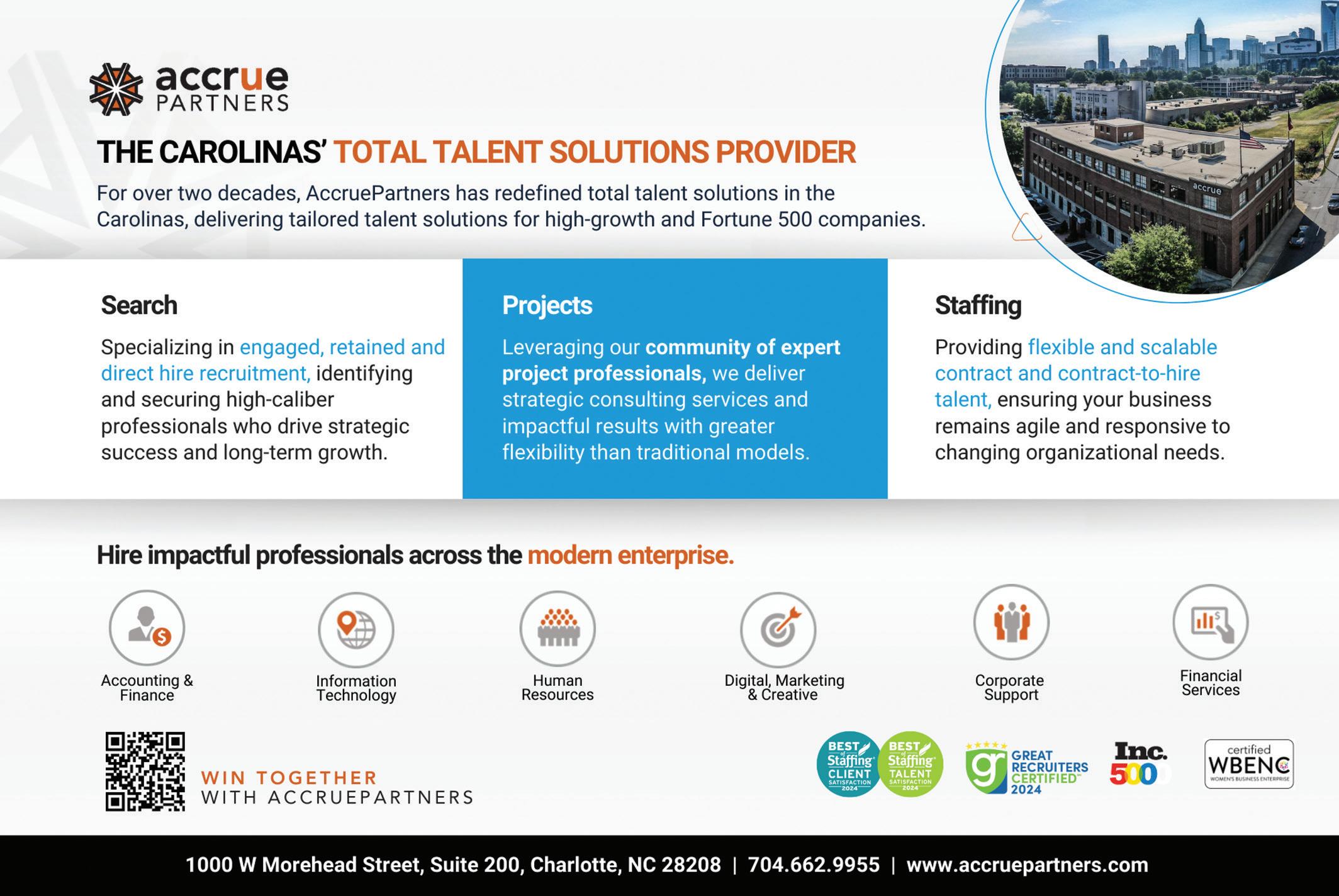
When we invested in the Blue Line in the early aughts, it was a bold move. I personally provided 30 tours to major cities throughout North America that wanted to understand what our vision was.
It’s a shame that it’s now been a couple decades, but I’m thrilled at who we’ve got at the table, the kind of vision that’s being shared and the kind of conversations that we’re having.
WALTON: When I first moved to Charlotte, you effectively felt like you had University, Lake Norman, Center City, South Park and then Ballantyne. Now you’ve got a lot of labels on neighborhoods in-between that are going vertical. So Charlotte for years grew out, and now it’s growing up to some degree.
A lot of companies, ours included, are encouraging people to get back in the office. We’re in Center City and glad to be there.
BEACHAM: We just finished an adaptive reuse of a mill in Belmont that leased up quicker than any project we’ve ever had. Yet the town of Belmont is using that as a reason to slow things down. I can only imagine what if it had been a bad project.
We see that in every bedroom community. It’s Matthews; it’s Fort Mill. You can’t argue with the folks that live there because many of them have lived there their whole lives and don’t want to see a change.
Still, Charlotte is the engine that makes them thrive. Ease of transportation might exacerbate their problems, so I think
that’s why you’re seeing some tension with some of these bedroom communities about future rail lines. They don’t want to lose what they’ve got.
SMITH: Absolutely. The ultimate test is whether our children want to return here? And we’re winning that game. Even the ones that want to go out, they want a boomerang back. It’s about being able to access the world but still have a place that is truly North Carolina.
WILSON: Another interesting thing is that the city is becoming a more august and sincere city. It’s becoming an older city. People get in their 60s and they say well I guess it’s time for me to self-segregate, and go to Sun City or Sea Pines or something. At 59, I don’t really have this desire to self-segregate from an urban environment that I find appealing.
WALTON: There’s more than 100,000 employees in the financial services industry in Charlotte. You don’t necessarily have to live in your headquarters’ city to have a meaningful job. Regions is the largest bank headquartered in the Southeast, based in Birmingham. There are a lot of senior leaders that live in Charlotte, and they hop on that airplane every Monday and come back on Thursday.
We have more than 400 employees who work in Charlotte. Most larger financial institutions have major
operations in Charlotte because it is such a talent pool.
PACK: People don’t realize until they get here all the other industries that are here. We have a lot of great companies in the middle market that aren’t name brand companies. They’re headquartered here. They’re global in nature. They create lots of jobs and lots of opportunities. I would say that’s a large piece of my customer base. We serviced 187 clients last year. Not Lowe’s and not Bank of America.
It’s been that mid-market customer that has really built the foundation of Charlotte and created a lot of great opportunities.
WALTON: Another important asset is the hospitals we have here. We forget how valuable of a resource that is to have in our backyard.
SMITH: And they keep getting stronger. This conversation about the diversification of our local economy is so key to where we’re going next. Financial services is an amazing base, but through our education system, through the kind of talent that’s coming here, and then also these new innovation hubs that are being created like The Pearl (which includes Wake Forest University School of Medicine). We are just starting to understand the amount of institutional capital and national labs money that’s possible.
WILSON: One sword of Damocles over the city and everybody now is environmental. For a week, the heat index reached 115 in Raleigh. That is something that can fundamentally change things. I think this city needs to think about things like our green canopies.
This time, it included some concerns about the health of our uptown. It was surprising because I seldom have to defend our city. ■

• Charlotte based buyout and growth equity investor
• ~$7B AUM
• Service and Distribution Business Models
• Sector Focused: Business & Tech-Enabled Services, Industrial Growth, and Healthcare
• Named to Mergers & Acquisitions’ inaugural “Best Places to Work in Private Equity” list
• Up to $500mm equity commitments
• North American headquarters
• Majority ownership or lead minority investor
• Equity for organic or acquisition growth
GROWTH-ORIENTED INVESTORS
• Ridgemont has more than doubled in size since 2010 to over 60 professionals
• We employ over 15,000 employees across our portfolio companies, and have increased the employee base by nearly 50% on average for realized investments
• ~20% average annual EBITDA growth for realized investments


Since 1993, the principals of Ridgemont Equity Partners have invested over $6 billion in 165+ companies. Ridgemont is the largest private equity firm in North Carolina and among the largest in the Southeast. The firm has been consistently named to Inc.’s list of “Founder-Friendly Private Equity Firms,” which recognizes Ridgemont for a track record of building leading middle market companies alongside entrepreneurs.
For the fifth year in a row, we are pleased to sponsor Business North Carolina ’s “Top 125 Private Companies” list and wish to congratulate the honorees!
Congratulations to our partners at National Power for being named to the 2024 list!

Headquarters: Raleigh, North Carolina
Ridgemont provided growth capital to National Power, a leading provider of power reliability solutions, in October of 2023.




As we embark on the years ahead, we are inspired by our past and guided by our vision for a bright future to continue to Be Greater.
DMJPS PLLC (DMJPS) is pleased to sponsor Business North Carolina’s Top 125 Private Companies. As a North Carolina CPA and advisory firm with a mountains to the coast footprint, we understand the pivotal and essential role privately held companies play in our state’s economy. We celebrate all who make North Carolina Be Greater and congratulate this year’s Top 125 Private Companies.
From the beginning, our mission has been clear: to exceed expectations, providing thorough and personalized support to our clients. And as we commemorate our 75th anniversary our commitment is unwavering and our journey forward is steadfast: to Empower You to Be Greater.
DMJPS CPAs + Advisors is a tax, assurance, and business advisory firm that routinely solves complex matters for privately held businesses, nonprofit organizations, and corporations with a wide range of specialized solutions. Clients work with us because we build reliable relationships dedicated to providing exceptional results and innovative solutions.
With North Carolina offices from the mountains to the coast in Greensboro, Asheville, Boone, Durham, Marion, Sanford, and Wilmington, DMJPS provides solutions from one reliable firm.
The DMJPS team of 165+ professionals is future ready through the firm’s advanced technologies, specialized industry knowledge, and a strong commitment to meaningful client relationships. Advisory services include business valuations, mergers and acquisitions, succession and exit planning, and healthcare practice consulting. DMJPS’ deep industry knowledge includes professional services, real estate, manufacturing, agriculture, and hospitality.
At DMJPS, being greater means more than just individual excellence and we understand that our success is intrinsically tied to the success of our clients. That’s why we’re committed to fostering long-lasting relationships built on trust, reliability, and expertise.
Business growth and opportunity is supported by a sustainable value system – one that your team relies on in times of rapid expansion or change. When you become a DMJPS client, everyone on our team works for you. Clients can expect a trusted relationship and a knowledgeable partner who is dedicated to supporting their financial needs. That is our commitment to you
For more information about DMJPS visit dmjps.com.





Passing Rick Hendrick on the annual BNC 125 is proving as challenging as keeping up with Jimmie Johnson, Jeff Gordon or other famous Hendrick Motorsports drivers on the NASCAR tracks.
The affiliated Hendrick Automotive Group dealership company again tops our annual list of the state’s largest private companies, which is based on revenue. Twentyfive companies turned over at least $1 billion last year, based on data shared by the organizations or research by BNC staffers. Among those leaving the list is Raleighbased Leith Cars, where Hendrick started selling cars in the mid-1970s. New Jersey-based Holman bought the business from the Leith family in March.










The list includes North Carolina-based companies, which are mostly closely held or family-owned enterprises. A growing number are owned by private equity groups.

Newcomers this year include mobilephone retailer Victra, engineering and design firm Kimley-Horn and National Power, which distributes generators and associated equipment.


Hendrick met with BNC at Charlotte’s NASCAR Hall of Fame, where his 40-year motorsports career is featured in a new exhibit. More than 100 employees attended an event honoring Hendrick, 75, and his wife, Linda. They’ve been married for 51 years. The interview was edited for brevity and clarity.


By Pete M. Anderson, David Mildenberg and Kevin Ellis
Are you pleased with how NASCAR is progressing?
You always think things could be better, but I feel like we’ve got a lot of good energy now. I think the future’s pretty strong. I feel better about NASCAR today than I did five or six or 10 years ago. I feel the electricity with the fans. And I think when you look at Amazon and people such as Netflix and those folks coming along, then that’s a great sign.
How has that happened?
I think there’s a lot of energy around the sport and sports in general. They see things like Kyle Larson running Indianapolis and the NASCAR race on the same day. And if you go up there and you see a sea of Larson fans at the race and then you look at how competitive it is. And then we ran over in Le Mans, France with our Garage 56 car. (It was the first NASCAR participation in the 24-hour race since 1976. )That blend of people who have never watched NASCAR races before are watching now. We’ve opened doors to a new generation of fans.

Why did you make the shift to defense work as a major part of Hendrick Motorsports?
When we quit building our chassis, we had a lot of people, really great folks, who were super-talented, then we found out that General Motors was going to build a military vehicle, the integrated surface vehicle. We said, `Let’s bid on that.’ In August, we’re getting ready to build our 1,000th unit here. And we’re expanding manufacturing. We have three or four items we’re doing for the Army. We are getting opportunities from a lot of different places to do prototyping and that’s because of our engineering talent and our ability to make anything, whether it’s carbon fiber or steel. And we have some of the best engineers in the world.
Couple that with GM, which has roughly 150 engineers right outside our gate. Put that many talented people together and there’s lots of opportunity.


How is your car business?
We’ve had some good years. COVID scared us to death, but we decided when COVID hit in March 2020 that we had to pay all of our people 80% of their wages rather than lay off anybody. I asked my CFO, `How long can we do this?’ He said probably 90 days. But in 30 days, business opened back up a little, and we kept all of our people in place. Then we had a record year and three or four really unbelievable years.
I am super-excited that we are the largest privately held autodealership group in the country, and we’re expanding. We’ve got five new dealerships under construction. We’re not slowing down for the next 50 years in the automobile business and the next 40 years in racing. I won’t be here, but I’ve got really good people.
What’s your view of the EV transition?
I think that the government pushed too hard, too quickly. You have to build what the consumer wants. Everybody pushed hard that the EV was the way of the future. Now there’s so many rebates on EVs, and Tesla is cutting prices, so cars are stacking up. The combustion engine is here for a long time.
And really what we’ve got is the hybrid, which is a little bit of both, and that’s the best. I mean it gives you the ability to run on a battery then run on gas and recharge the battery. I think that’s the best of both worlds.
There’s definitely a market for EVs, but it’s around 8% or 9%, not 50%, in the next 10 years. That’s just not going to happen. We don’t have the infrastructure. I have a dealership in California, and we have rolling blackouts there. So if you shut down your business or your air conditioning at your house, why do you want to have everybody driving electric cars? The cars have to be charged. That makes no sense.
manufacturers like dealing with us, because we can make decisions without a board of directors, and we invest in our people in the franchise.
I’m not saying the public companies don’t. They are driven to make a profit and so am I. But they’re driven to create 20% growth, and they have to push to get there. I take care of my people first, and if you take care of the people, they’ll take care of you. We have less turnover. And when you rank us against the public companies with awards and everything else, we outperform them.
What would you tell other CEOs about creating a loyal staff?
I study companies that fail rather than companies that are successful. And so I watched Kodak. I watched a lot of different companies that have failed, and they resist change. If you take care of the people, they’ll look after the company. And if you can keep the people together working as a team, and if they know you’re going to look after ‘em with insurance, you have less turnover. I look at some of the CEOs that come in from other businesses; they have no experience in the company they’re running. They’ve been handpicked by some board of directors to run a company they know nothing about. They don’t care as much about the people. I tell our people all the time that communication is key.

I think it is going to continue to evolve, but it’s not at the pace that the government wants to see it happen. We still don’t have the infrastructure for it.
Who has the best strategy among the automakers?
Ten years ago, I remember Toyota telling me that in 2023 or 24, about 8% of the U.S. market would be EVs. That’s happened. And they said hybrid is the way to go, which is also true. All of the literature is giving Toyota credit for reading the tea leaves.
Everybody’s building hybrids now. At the BMW plant down in Spartanburg, on the same assembly line. They can build gas, hybrid or electric. They can switch and build what the customer wants. You can’t force it. I don’t care how much rebate and incentives you put on a car, people are not going to buy what they don’t want.
Will Hendrick Automotive remain private long term?
I do not want to be public, and I don’t want to sell it. Our numbers are as good or better than the public companies. The
You’ve been a key part of building Charlotte. Why has it been a good place for your business?
Actually I ran stores for someone else in Raleigh, then I moved to Bennettsville, South Carolina, to run a little broken dealership, because that’s the only way I could get in line for a Chevy store. GM promised me if I could fix it, they would give me a bigger opportunity. And then City Chevrolet [in Charlotte] came available. It was the primo deal in the state, and I took it, and we just exploded
And then racing was right here. I grew up on a farm when my dad raced, and I’d go on Saturday night with him. I used to drag race, and I knew people at GM through my dad that had racing parts. So when the teams around Charlotte that weren’t sponsored by GM would come to me, I’d help get ‘em parts.
One day I got a call from Max Muhleman, who was a Charlotte writer and [marketing company owner], and he said, ‘How would you like to be partners with Kenny Rogers and have Richard Petty drive the car?’ I thought, was this a trick question? And I knew Harry Hyde as the crew chief. So we put All Star Racing together. Then Petty backed out, the sponsor backed out and Kenny Rogers backed out. I got to Daytona with my bloomers around my ankles.
We’ve just had good luck and been blessed by our faith. I don’t know how it all happened. All I cared about was racing and automobiles. My dad and I built my first car when I was 14. I still have it. So I’m a car junkie, and I love racing. Outside of my family, the two things I enjoy are the automobile business and racing. I get to make a living doing the two things that I enjoy the most. ■




In October, veteran Charlotte finance executive Jeff Brown succeeded Greg Gach as president of the largest U.S. privately owned auto dealership company. American Banker named Brown “Banker of the Year” in 2022 for leading Ally Financial, where he was CEO since 2015. Hendrick has been a longtime customer of Ally, which rebranded from GMAC, the former finance unit of General Motors. Brown’s work includes maintaining Hendrick Automotive’s four-year run as the top-ranked dealer group for online reputation, according to the Reputation.com website. Hendrick has more than 11,000 employees at 94 dealership locations, 21 collision centers and four accessories distributor installers in 13 states. The company is building facilities in five cities. In June, Hendrick donated about 23 acres of land to Central Piedmont Community College for its campus in southeast Mecklenburg County. $1 BILLION AND MORE





Changes at some BNC125 Top Private Companies during the past year.
The video-game company remains a powerhouse because of its Fortnite and Unreal franchises, attracting $1.5 billion in capital from Disney in February. Its valuation was then reported as $22.5 billion, according to industry publication Information. But growth is harder to come by; it laid off 16% of its staff last fall, about 800 people, including 170 in the Triangle. The valuation is lower than Epic had previously reported. In July, Alain Tuscan, the company’s executive vice president of game development, left to become president of Netflix Games. Co-founder Tim Sweeney retains a net worth of about $5.7 billion, Forbes estimates.
For the first time since its 2015 sale, the department-store chain isn’t controlled by New York private equity group Sycamore Partners. In July, Belk said it reduced debt by almost $1 billion and secured $485 million in capital in transactions that put controlling interest with its lenders, including New York investors KKR and Hein Park. The Belk family sold the business to Sycamore Partners for $3 billion, amid a long-term slide in the department-store industry. The chain operates about 300 stores.

Charles Heilig, who has been president of the Gastonia-based textile company since 1998, will chair the National Council of Textile Organizations, a trade group representing the U.S. fiber, yarn, fabric and textile industries. The Greensboro native is a graduate of NC State University. Parkdale is the largest consumer of cotton in the U.S. with 29 plants in the U.S., Mexico and South America, according to its website.
Greenville’s Rich Balot has built his chain of Verizon retail stores from one to more than 1,700 over the past two decades, earning him designation as a winner of EY’s Entrepreneur of the Year Southeast Award. He sold controlling interest in his Victra retail business to a private equity group in 2015, came back as CEO in 2019 and regained a majority interest in 2021. It made its biggest acquisition, Go Wireless, in 2022.

Last summer’s purchase of seven dealerships in South Carolina from MCE Automotive Group represented almost $500 million in annual revenue for Raleigh-based Anderson. The family owned dealership group ranked 71st nationally in 2022 unit sales, according to Automotive News. The acquisition of Chevrolet, Genesis, Hyundai, Kia, Nissan and Toyota dealerships in the Upstate South Carolina, area pushes Anderson’s total to 18 properties. Andy Anderson started the company in 1955. It’s now led by his son Fred and grandson Michael.

The family-owned Greensboro company is ranked as the largest N.C.-based company on Engineering News-Record’s list of 400 biggest contractors, with revenue topping $1.4 billion. Among its biggest projects is the 27-story Oro Ballantyne apartment building in south Charlotte, developed by Northwood Office. Samet also is building a 19,340-square-foot terminal at Statesville Regional Airport that is expected to be completed in fall 2025.

$500 MILLION TO $999 MILLION






Will Loughran joined the Raleigh-based hotel company in April as chief operating officer, overseeing more than 140 properties. He had spent the previous nine years at San Clemente, California-based Evolution Hospitality, which more than tripled to 100 properties during his tenure. He previously worked at Richfield Hospitality, Sage Hospitality Resources and Marriott International. Concord is considering international expansion beyond its U.S. and Canadian markets.



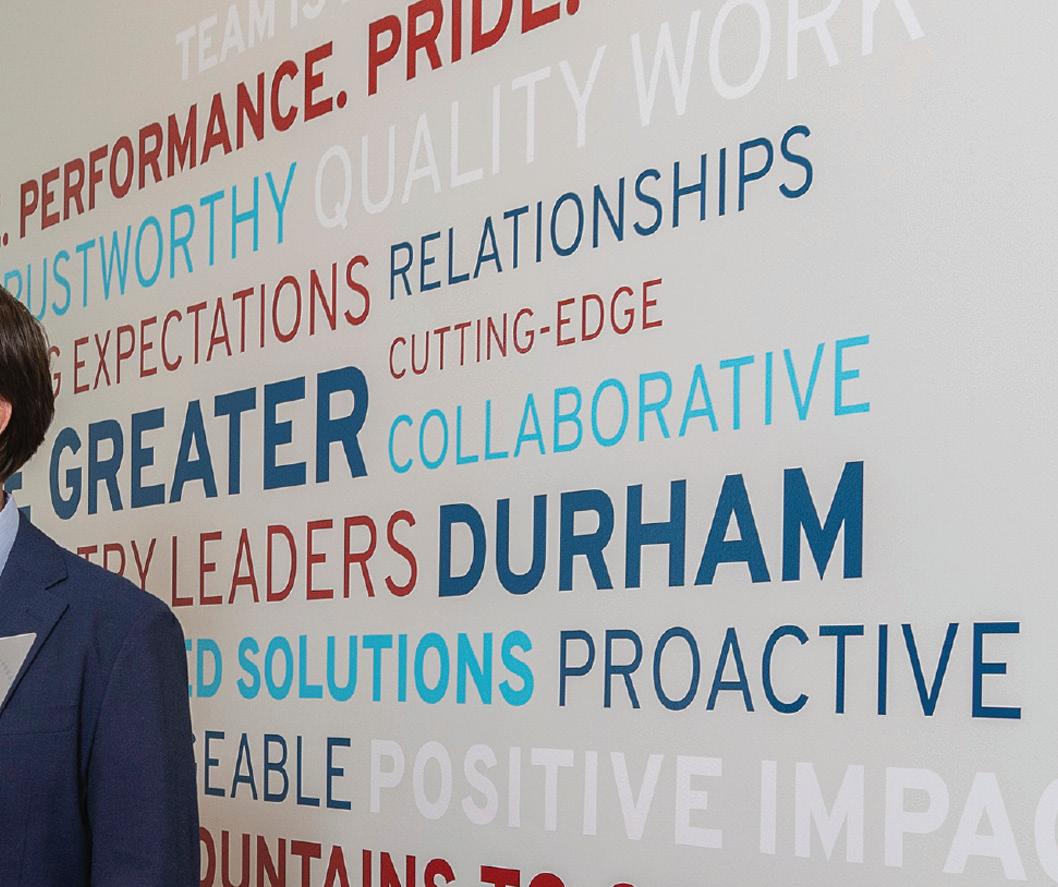

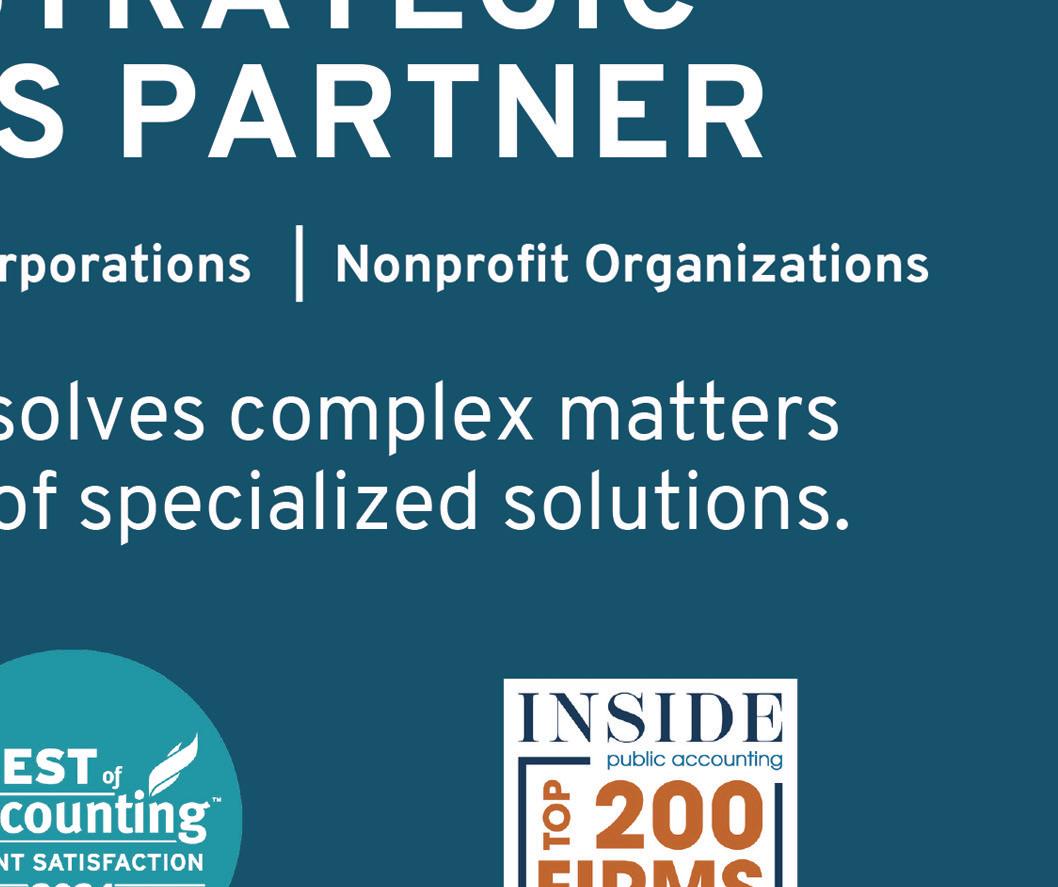


$300 MILLION TO $499 MILLION





The industrial parts company makes 5 billion high-precision components annually at 28 plants in 19 countries. It is considering a potential sale, Bloomberg News reported in April, though the company provided no comment. It is owned by three privateequity investors: Switzerland-based Partners Group, New York-based Kenner & Co., and American Industrial Partners. CEO David Angell was a longtime leader of Form Technologies subsidiary Dynacast.


Founded in 1976 and specializing in running gear, it has 273 stores in 40 states and Washington, D.C. It has another 20 Marathon Sports locations, which were acquired in 2022. Two-thirds of the stores are owned by franchisees. Joey Pointer is a 20-year veteran of the company who became CEO in 2017. About 75% of sales come from footwear. Fleet Feet plans to open 15 stores this year.

Carolina Panthers owner David Tepper agreed in July to keep the team in Charlotte for 20 years as part of an $800 million plan to renovate Bank of America Stadium. About $650 million will come from Charlotte’s hospitality and tourism tax; Tepper will cover the balance. While the Panthers have not been successful on the field, the NFL and Charlotte FC games and other stadium events are major economic jolts for the Queen City, city leaders say.




Dr. Leo Spector succeeded Bruce Cohen as CEO in January at the practice that he joined as a spine surgeon in 2007. Started in 2005, OrthoCarolina has more than 112 physician shareholders, 472 medical providers and 1,700 employees. Its more than 30 practices stretch from Boone to Bennettsville, South Carolina. Spector is OrthoCarolina’s first CEO with an MBA. He earned the degree from Duke University in 2020.

In mid-2023, Prometheus Group received a major investment from private equity groups Advent International and Leonard Green & Partners. Genstar, which acquired Prometheus Group in 2019, and Eric Huang, the company’s CEO and founder, retain meaningful stakes. Its software support enterprise research plan providers such as SAP and Oracle. Huang is a graduate of NC State University who says Prometheus operates “in a boring space” with little competition, WRAL Techwire reported in 2019.

Tencarva acquired West Virginia-based Tri-State Coating and Machine in May. It was the second acquisition for the 45-yearold Greensboro business since it partnered with New York-based private equity group Bessemer Investors in 2021. Tri-State specializes in thermal coating services. Tencarva distributes and services flow control and processing equipment for industrial and municipal customers.


$150 MILLION TO $299 MILLION





e self-described family-owned company says it holds majority interests in its solar and battery storage projects. Two noteworthy ones are going on in Phoenix. In January, it broke ground on a 1-gigawatt battery storage complex that is expected to open in April and store enough electricity to power 50,000 Arizona homes during peak summer demand for 20 years. In July, Durham-based Strata made a similar deal with Arizona Public Service for a storage complex to power about 24,000 homes, pending its expected completion in April 2026.




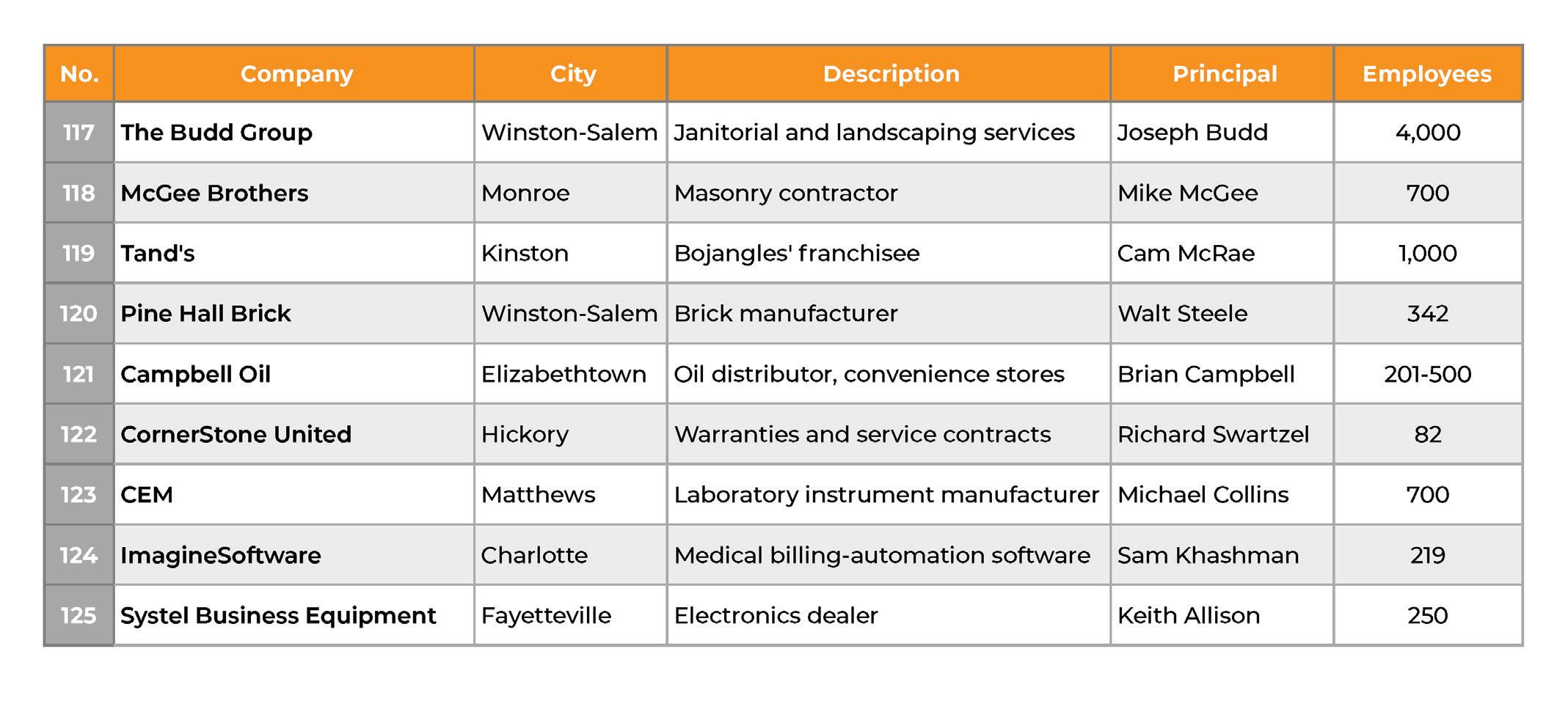


Founded in 1973 and based in Raleigh, N.C., Golden Corral is the nation’s largest buffet restaurant chain, maintaining a tradition of providing a pleasurable dining experience for their guests by offering an unmatched variety of delicious foods at an incredible value. Service to others is also a hallmark of the Golden Corral brand. Made possible by the generosity of guests, franchisees, and employees, Golden Corral restaurants have raised over $34 million for military families in conjunction with DAV (Disabled American Veterans) and Camp Corral, a nonprofit organization devoted to supporting children of our nation’s wounded, ill, and fallen military heroes.

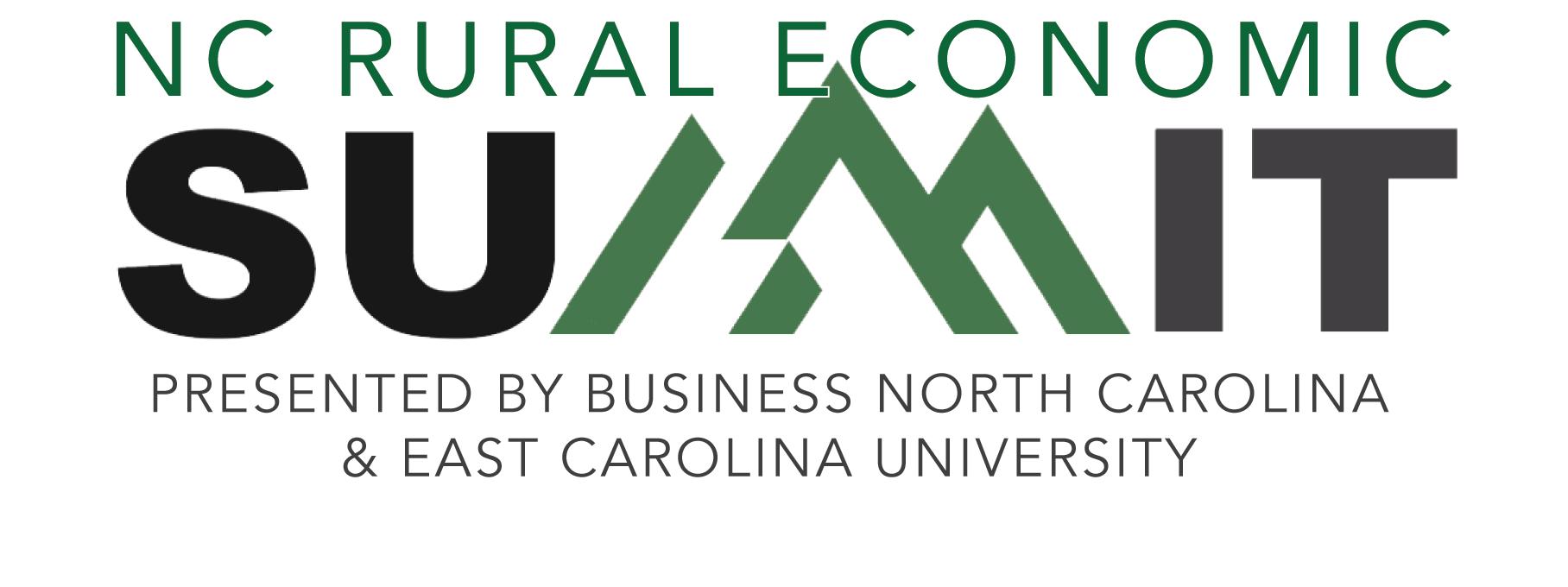



The NC Rural Economic Summit aims to build powerful networks of passionate, engaged, innovative business leaders in rural North Carolina willing to share ideas and resources and take action to strengthen their small communities across the state. It will consist of a two-day conference focused on addressing the challenges, opportunities and collaboration of businesses and business supporters in rural North Carolina. Business North Carolina’s annual Trailblazers award winners will be honored at a gala and programming will include sessions covering important topics to rural NC businesses including: Entrepreneurship/Small Business, Healthcare, Education/Workforce, and Broadband/Tech.




In October, Charlotte-based Ridgemont Equity Partners led a recapitalization of the Raleigh-based company that was founded by Eddie Youngblood in 1985. The company provides power reliability and resilience solutions, such as generators and batteries, for more than 1,500 customers across many industries. It is led by CEO Chris Hutter, who joined National Power in 2020 after working as chief operating officer of PowerSecure, a unit of Southern Company.


Herb Evans, vice chair of the Rocky Mount-based company, was chair of the National Tank Truck Carriers trade association in 2023-24. He met company founder Don Stallings while the two were growing up in Atlantic Beach in the 1950s. The company runs 550 diesel-powered tractors and 800 tank trailers and employs more than 1,000 people, according to Bulk Transporter, a trade publication.

Since 1988 Nottingham has been providing consulting on investment fund organization, and ongoing operations support with fund accounting, compliance administration and transfer agent for those funds. Nottingham manages relationships with service providers for its pooled vehicle clients, custodians, outside legal counsel, independent auditors, Authorized Participants and market makers for ETFs and prime brokers for private funds. In 2019 and 2022 Nottingham was honored with the Fund Intelligence Award for Best Fund Administrator for Small and Start-up Funds. Nottingham has been named to the Best Employers in North Carolina every year since first invited to participate in 2019.




From our humble beginnings in 1952, Vannoy Construction has always maintained a family atmosphere among its employees, subcontractors, partners, and clients. When we first opened our doors, business was done on a handshake and a person’s word was all you needed to know the job would be done right.

Vannoy Construction’s culture has consistently been defined by the character of its founders. More than 70 years ago, Jim and Wilma Vannoy started a family company with North Carolina mountain roots which fostered the character of our people; and that character remains today under the leadership of their sons, Eddie and Mark Vannoy.
NC: Jefferson (HQ), Charlotte, Winston-Salem, Asheville
SC: Anderson, Charleston, Greenville
VA: Lynchburg
We call this character the 4Hs – Honor, Humility, Hospitality and Hustle. Different than Core Values or Mission Statements, the 4Hs are our behavior standards and are expected to be visible in our everyday interactions. Together, these attributes built our reputation and define our working relationship with every customer, partner and vendor we work with every day.
Today, with projects exceeding $280M and annual revenues exceeding $850M, that same focus on commitment and honor remains.


Earlier this year, the Charlotte paving contractor completed an employee stock ownership plan that put company stock in the hands of more than 800 people. Blythe family members, who have controlled the business since its formation in 1921, viewed the change as a way to maintain family involvement and as a way to reward and retain employees. The company ranks among the largest 400 U.S. contractors, according to Engineering News-Record.

After operating as Trialcard for two decades, the company rebranded last year to Mercalis, a Latin word related to “for commerce” and shorthand for “commercializing life sciences.” The company helps life-sciences businesses commercialize their drugs and other products. It has been owned since 2017 by Odyssey Investment Partners.
This marks the eighth consecutive year that the insurance network has added at least 1,000 agencies. Douglas Witcher started the business in 1994 as a network for independent agencies to broker a variety of insurance products. More than 10,000 agencies are now part of Smart Choice.

Seventy-eight years after Bill and Roberta Zimmer opened a store in downtown Wilmington, the Zimmer family in July celebrated a renovated flagship hometown location in the Port City’s Mayfaire Towne Center. Reeds is the largest family-owned jewelry store chain with about 65 stores in 13 states.

The company launched in 2013 hit some key milestones in the past fiscal year, including topping $200 million in annual recurring revenue, launching a record number of new products and adding more than 400 customers. Pendo counts as customers nearly half of the top 100 public software companies by market cap. In July, Pendo bought New York-based Zelta AI to expand its artificial intelligence functionality. ■




The state’s influential clinical research industry looks to accelerate, fueled by artificial intelligence.
By Michael MacMillan
As an Oscar-winning 2022 movie noted about another kind of ubiquity, arti cial intelligence is now “everything, everywhere all at once,” and that includes North Carolina’s multi-billion dollar clinical research outsourcing industry.
Early applications are basic, such as identifying potential drug therapy candidates and patient populations, accelerating clinical trials and general paper shu ing. But that is likely to change.
“Our industry is in the same place as most people with AI,” says Paul Evans, CEO of Durham-based Velocity Clinical Research, which has grown to become one of the state’s largest private companies in recent years. “We’ve seen a step change. Everybody started with e ciency gains, back o ce functions. en you move on to how you use AI to transform the industry.” As to the latter, Evans says, “We’re not there yet.”
Given rapid advances in technology, a more radical transformation may be coming. Joachim Bleys, a senior partner at the consulting rm McKinsey, says AI will help drug companies
lower administrative costs and accelerate their trials through enrolling patients more quickly and making better use of data.
“For earlier stage research, we see AI truly transforming the quality of assets that make it into the clinic, drastically changing time to market and also probability of success.”
Because AI is moving so quickly, the challenge for industry is determining potential bene ts and “how do you harvest that potential,” Evans says. “ at’s not easy to discern at this point.”
e story of the clinical trial research outsourcing isn’t a pageturner; it’s an industry that operates largely behind the scenes. Its roots trace back at least to 1753, when Scottish physician James Lind’s controlled trial examined whether citrus fruit could combat scurvy on a British naval vessel. Spoiler alert: lemons, oranges and grapefruit protect against the disease.




















North Carolina’s CRO industry is of a more recent vintage. Its founding is generally attributed to British ex-pat Dennis Gillings and Gary Koch, who were biostatistics professors at UNC Chapel Hill when they launched Quintiles in 1982. It went public in 1994, reverted to private ownership in 2003, then did a second IPO in 2013. It merged with IMS Health in 2016 to form Durham-based Iqvia, which employs 87,000 people and has a market value of $45 billion.
Another early entrant was Wilmington-based PPD, founded by Fred Eshelman in Maryland in 1985 as a one man consulting rm. He moved to North Carolina the following year and, a er a series of ownership shi s, PPD was acquired by ermo Fisher Scienti c for $17.4 billion in 2021. Eshelman has spun out other companies, while donating more than $140 million to UNC Chapel Hill.


Iqvia and PPD bene ted from an ecosystem that provided both talent through the area’s multiple research universities and potential clients in the form of major pharmaceutical companies located in the Triangle.
anks to Iqvia, PPD and others, North Carolina is now at the center of the CRO world with 167 companies and 24,613 employees as of late 2023, according to the North Carolina Biotech Center. e average salary for a clinical research associate in NC is about $85,000, according to the online recruiting rm, Indeed.

Yet, beyond the reams of data generated by these trials lies the impact on real lives, and on the fortunes of entrepreneurs, venture capitalists, and pharma executives. More recently, the industry has seen some consolidation, along with a steady ow of new therapies and drug trials. And there has been the pandemic.
“If you look at recent trends, the market started to heat up a little before Covid,” says Matt Jenkins, a partner at Raleigh-based private-equity group QHP Capital, which has invested in clinical research groups and a liated vendors. “ ere’s a lot of new platforms for drugs, lots of therapeutics being developed, lots of cell and gene therapies. It’s been a sea change, a shi toward precision medicine.”
While the pandemic led to a spike in trial activity, long-term growth is dependent on R&D spending and the willingness of pharma and biotech companies to outsource some of their work, says Truist analyst Jailendra Singh. Both have been moving in the right direction of late. “Overall, research spending is growing around 5-6%,” he says, “with large pharma spending slightly less and emerging biopharma companies at a much higher rate, the low to mid-teens.”
Emerging biopharma companies bene ted from robust funding during the peak of the 2020-21 pandemic, but things cooled o in 2022-23, Singh says. “Now, the environment is improving, supporting further investment in R&D and, ultimately, in outsourced drug trials.”
Velocity Clinical’s Evans says, “ ere’s plenty of capital around. What you need is good ideas to use that capital.”
e numbers suggest the ideas are out there. Biopharma funding gained 56% in the rst half of this year, versus a year earlier, according to Truist. Clinical trial starts rose as well, climbing 32% through mid-year, versus 2023. ere were 1,077 clinical trial starts in June, compared with 867 starts in May. About 40 or 50 “novel drugs,” which have never been approved, get OK’d annually in the U.S.
Among North Carolina’s many clinical research organizations, Velocity Clinical Research is among the compelling rapid-growth stories.
Incorporated in late 2017, the company initially grew by buying regional U.S. sites, but has expanded globally more recently. It was the only company that conducted trials for all of the pharma companies included in the Operation Warp Speed program to help accelerate research of drugs to ght the coronavirus. By 2021, it operated 14 sites in 11 states.
Velocity was initially backed by an investor group led by Washington, D.C.-based NaviMed Capital, which sold the business in 2021 to London-based Global Healthcare Opportunities for about $500 million, according to PE Hub, an industry publication. GHO has invested more than $5 billion in about 24 companies over the past decade.
ree years later, Velocity has 90 sites in the U.S., United Kingdom, Germany and Poland, and a database of more than 1 million patients. It also established a tech hub in Hyderabad, India to develop proprietary patient recruitment and engagement technology. Inc. magazine ranked Velocity as No. 543 on its list of the 5,000 fastest growing U.S. private companies in 2023.
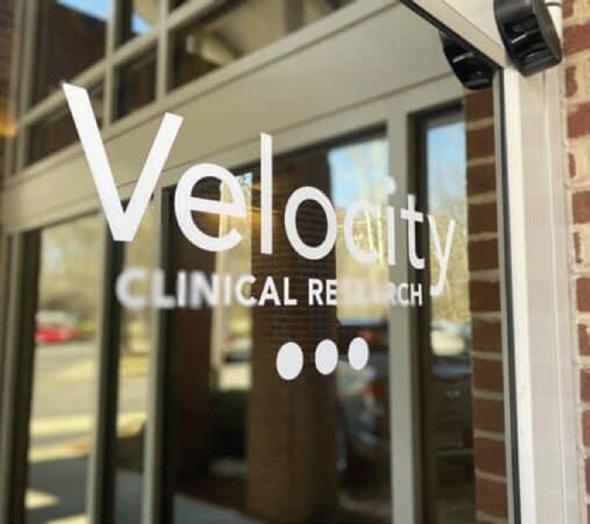
e use of outsourcing for drug research ebbs and ows constantly, with McKinsey’s Bleys comparing it to a pendulum swing. “ e bene t of working with a CRO is that you don’t have to build a big organization, so you’re not stuck with the cost,” he says. “ e disadvantage is that you lose some proximity to your trial site.”
Within the industry, CROs seek to di erentiate themselves by scale and by specialization. Big ones argue for the bene ts of deep resources and global reach. Smaller- to mid-sized CROs tend to position themselves as having deeper, narrower, expertise in speci c therapies and patient populations, while o ering a better customer experience.
In structuring a trial, big pharma companies have the luxury of using their own resources or outsourcing. “Biotech (companies) are not interested in building their own in-house capabilities,” Bleys says. “ ey’re always going to work with a CRO.” at creates the opportunity for smaller companies to step into the role of “adviser to the CEO, and a true partner. e drug succeeding or failing is the most important thing that’s going to happen. If the drug fails, your biotech company is gone.”
e combinations involving Iqvia and ermo-Fisher Scienti c have consolidated the industry, but also opened doors for smaller, nimble companies. “Because the top seven or eight CROs have so much market share, about 70%, it’s a huge opportunity to take market share from the incumbents,” says Evans. “Smaller biotechs and smaller and mid-sized pharma are always going to look at (the trial process) and say we don’t get enough attention. at’s been the story in the industry for 30 years.”
A February industry survey from Worldwide Clinical Trials found that “pharma and biotechs favor midsize contract research organizations due to personalized service” and concerns about high development costs, among other reasons. at Worldwide is itself a midsize CRO makes the nding unsurprising, but it ags what some see as a trend.
Leading that growth since 2018 is Paul Evans, who had spent the previous 26 years at various clinical research groups including Parexel, Iqvia and Synexus. He has a Ph.D. in biomedical engineering from the University of London.
In July, Velocity hired Mike Zaranek as chief nancial o cer, a post he previously held at Morrisville-based Science 37, which went public in 2021. Velocity is considering a potential IPO, Axios reported in May. e company has declined to comment on that report.
“What we have clearly heard from some of the larger sponsors is that they are feeling disenfranchised,” says Sara Davis, executive vice president and chief commercial o cer at Durham-based Worldwide. “ ey’re not feeling they’re getting that customer service when issues arise.”
As a result, she says, “ e criteria by which some of the larger sponsors are selecting CROs has changed. It has been quanti able, numbers based. (Now) our larger sponsors are asking ‘how do you innovate?' 'What di erentiates you?' 'How are you going to grow with the partnership?'”

Bigger pharma companies are de nitely outsourcing more, says Jenkins. “It just makes economic sense. You’re going to see a lot more specialization as the complexity of therapies rises,” he adds.
But the big CROs aren’t standing still. " Iqvia, Icon, the big guys, they have historically been focused on large pharma, but now they’re expanding to emerging biopharma and mid-size pharma companies,” says Truist’s Singh.
Adds Evans, “All of the big CROs have tried to adapt by creating business units that focus on those smaller companies. Whether that’s e ective is an open question, but they recognize the challenge they face and are trying to address it.”
e CRO industry has historically seen the kind of steady growth that tends to attract nancial buyers. “When you look at funding trends, it’s important to look at the last ve or 10 years, and not just the post-pandemic period,” says Jenkins. ‘ e nature of clinical research is that it is increasing in both quantity and sophistication and that’s driving the need for specialized outsourcing.”
Broadly speaking, there are two kinds of acquirers in any market – strategics, generally competitors looking to add to a portfolio of products or services, and nancials, with capital to deploy and a goal of maximizing returns for investors.
think the public markets have an appetite to see more of these companies.”
e industry continues to create new companies, including various suppliers. “ ere are a lot of people who have made their careers here (in North Carolina) in CROs and that creates a lot of spin-out services,” he says. “ e nature of clinical research is (that it is) increasing in both quantity and sophistication and that’s driving the need for outsourced services, more CROs and deeper levels of expertise.”
One issue for further expanding the reach of AI into the industry is data quality. “Having good data sets, rst to train AI and then to learn, is not so easy, especially when you’re talking about patients (and electronic medical records),” Evans says. e records are “only as good as what the physician put in there. ere’s a lot of data around, but it’s not clear what the quality of that data is.”
“ eoretically, AI can do a really nice job to nd patients who t (a trial),” says QHP’s Jenkins. “If you have good data and lots of it, AI can nd very interesting things that a human won’t necessarily nd at rst glance. It’s not there quite yet, but you will see more and more adoption of AI earlier in the drug discovery process.”





QHP’s Jenkins says that, over the last ve or six years, there has been a “signi cant appetite for CROs in private equity. ere are a lot of these bigger players rolling up the smaller and mid-sized companies.” As to the nancial buyers, “( ey) are all over the map in terms of small, medium, and large (CROs),” he says. “ ere’s de nitely a lot of consolidation, especially in the middle tier. I don’t expect that to stop any time soon.”












AI may favor the larger companies, who can call on global datasets to train their algorithms. Evans isn’t so sure. “None of us know yet how the AI industry is going to evolve. Are there going to be AI vendors who are industry agnostic or is it expertise that you have to bring in house? e answer is probably both.”





Because of the M&A activity, there are only about ve or six “pure play” publicly traded CRO companies, Jenkins adds. “I







So the pendulum will continue to swing with one thing seeming certain: drug development is unlikely to become less complex. at should be good for North Carolina’s CRO industry, large, small or in-between. ■



Raleigh's NovaQuest expands beyond financing drug trials to startup investing.
By Chris Roush
Ramin Karimpour, the CEO of agriculture-tech startup Targan, had been funding the company with a variety of government grants and even his 2015 $1million dollar ticket. But he was about to close shop on the business, which he operated out of a 480-square-foot apartment.
Disappointed by the difficulty raising money to fund his Raleigh company, Karimpour was ready to accept an offer from a Japanese company to run its U.S. solar business.
“It was very frustrating,” says Karimpour, who had built a machine that could vaccinate 100,000 chickens each hour. “People didn’t understand what we were trying to do. This is not a very sexy business.”
In the nick of time, he grabbed the attention of Raleigh’s Oval Park Capital, which invested in TARGAN. That led to additional investments from Merck Animal Health and Mountain Group Partners and Raleigh-based NovaQuest Capital Management, which led a $35 million investment in 2022. Now, TARGAN expects to become profitable in the second half of 2025, CFO David Price says. He credits Novaquest Managing Director Brian Axe with helping the business secure additional financing earlier this year.

Targan’s song and dance with the venture capital community is illustrative of what hundreds of startups are encountering in North Carolina—they’re all seeking money to make their business y during a time of shrinking funding. Venture capital funding in North Carolina declined by 38% in 2023 to $535.4 million, according to the N.C. Biotech Center. at compares with a veyear average of about $691 million and a record of $907 million in 2021.
e trend isn’t improving, either. In the rst six months of 2024, VC funding dipped 21.4% to $270 million, according to the biotech center. As it has historically, North Carolina lags way behind Silicon Valley and Boston when it comes to funding ideas, whether it’s a new drug or transformational new technology.
California had $81.6 billion in venture capital investments in more than 4,000 companies in 2023, more than four times the value of the next closest state, New York. Massachusetts had $7.7 billion in VC investing in 2023. (North Carolina ranks No. 10 in the country.)
Mike Carnes, vice president of emerging company development at the N.C. Biotech Center, says a decline in initial public o erings and outright sales of companies has meant VC rms are holding on to their investments for a longer time, decreasing the capital available for new investments.
“It’s taking much longer, so companies have to be more patient and take alternative investment strategies,” says Carnes. “Most early stage companies are going to have to be pretty scrappy. ey’re going to have to diversify their options. We just don’t have enough local capital to support all of these companies.”
Durham entrepreneur Robbie Allen, who raised money for his Automated Insights and Bionic Health startups, also notes that
higher interest rates have pressured venture capital investing. “ ey go in preservation mode and extend their fund as long as they can, which means they don’t spend their money, or they spend their money judiciously,” he says. “ ey’re much less likely to invest in companies.”
Several North Carolina-based funds are trying to change that mentality and help make North Carolina more competitive with other regions. None has been as active, in terms of total funds raised, as NovaQuest.
e Raleigh-based rm was founded in 2000 as an investment arm by Quintiles Transnational (now IQvia) founder Dennis Gillings, a former UNC Chapel Hill statistics professor and British expat who saw the need for investments in companies developing drugs. Gillings is no longer involved in the management, but he still provides insights on markets, trends and opportunities.
NovaQuest split o from the drug -testing giant in 2010 and has raised more than $2.5 billion that it has invested in biotech rms and other companies. at makes it arguably the largest biotech investor in the state. It’s governed by a management committee, and its investments have resulted in 17 new drugs and an additional 24 potential drugs in development.
NovaQuest o en complements its in-house expertise with the development and commercial analytics at IQvia, which formed in 2016 a er Quintiles merged with IMS Holdings. Since then, the Durham-based company has nearly doubled in size to more than $15 billion in annual revenue with a market value topping $43 billion.
NovaQuest spun out its private equity team in 2021 and the business, now called QHP Capital, focuses on tech-focused life sciences rms and pharmaceutical services companies. QHP



NovaQuest provides $1 billion-plus in financing for life sciences and tech companies.
NovaQuest raises $459 million for its first fund.
Quintiles merges with IMS Health to form IQvia. NovaQuest starts private equity investing with an expanded team.
NovaQuest fifth Product Finance fund raises $1.2 billion and $275 million for private equity deals.
Quintiles Transnational forms NovaQuest as a strategic investment arm.
Quintiles spins out NovaQuest Capital as an independent firm, led by Ron Wooten.
NovaQuest's Product Finance Fund IV raises $900 million.
IQvia veteran Patrick Jordan joins NovaQuest as managing partner.


NovaQuest expands into the animal health industry.
Source: NovaQuest Capital Management, Wall Street Journal, Triangle Business Journal



Brian Axe▶
NovaQuest, Partner
The former Eli Lilly & Co. research executive joined NovaQuest as a principal in 2017, became a managing director in 2021. He leads the company’s animal health strategy as a portfolio manager, while also seeking investments.
◀Dennis Gillings
CBE, Quintiles Founder
The former biostatistics professor launched Quintiles in 1982. He retired as board chair in 2018 after the merger creating IQvia in 2016. He led the creation of Novaquest and remains a partner. Forbes estimates his net worth at $2.3 billion

has invested more than $1 billion in about a dozen companies, according to its website. (Business North Carolina pro led QHP Capital in July 2023.)
Meanwhile, NovaQuest has stuck to biopharma and animal health operations. It has now invested in more than 35 biotech rms and ve in the animal health industry. It has ve partners and an 11-member investment team, which includes liaisons from Japan’s Mitsui & Co., exploring potential investments. e company’s mainstay strategy is to invest through nancing or licensing deals where it is paid royalties based on a drug’s sales a er it receives regulatory approval. In 2022, for example, it provided San Francisco-based FibroGen with $50 million in exchange for 22.5% of royalties from Evrenzo, a drug to treat anemia caused by chronic kidney failure. NovaQuest’s royalties were capped at $125 million in that deal.
But in the case of Durham-based Viamet, NovaQuest decided to buy the whole company and insert its management.
Former UNC Chapel Hill Chancellor Holden orp started Viamet in 2004 a er his previous company, Xanthon, ran out of money and closed two years earlier. Xanthon was a bioinformatics company with detection technology for analysis of DNA, RNA and proteins. “It was a combination of 9/11 and technical challenges and being close minded about how we could have exited,” says orp, now a chemistry professor at George Washington University in Washington, D.C. “We ran out of venture capital and shut it down.”
A Xanthon investor asked orp if he had other ideas for a business. orp said he wanted to explore new ways to create drugs

Holden Thorp▶ Chemistry Professor
The Fayetteville native cofounded a drug development company now owned by NovaQuest. Thorp was chancellor at UNC Chapel Hill from 2008 to 2012, provost at Washington University in 2013, then chemistry professor at George Washington University in 2023.
◀Patrick Jordan
NovaQuest Managing Partner and COO
The veteran Quintiles/IQvia executive was an original member of NovaQuest’s team. He is managing partner and chief operating officer. He has bachelor’s and MBA degrees from Duke University

that would treat infectious diseases without causing side e ects.
But when it came time to nd some funding, “because there are so few funds in North Carolina, there weren’t a lot of others for us to go to.” One reason is that many out-of-state investors prefer not to travel for board meetings and site visits, he adds.
Viamet’s team conducted studies on treating ailments such as athlete’s foot, nail infections and chronic yeast infections, but realized it needed more money to conduct a Phase 3 study of one of its drugs. at’s the last step before applying to the U.S. Food and Drug Administration for approval.
Strong data from the rst two phases of testing a drug to treat chronic yeast infections, as well as Viamet’s management, caught the attention of NovaQuest, says managing partner Patrick Jordan, who had returned to the investment rm a er working at Quintiles and IQVIA.
NovaQuest declined to disclose its investment in Viamet, which it acquired in 2018 and has renamed Mycovia. But Jordan became its interim chief executive o cer and is now chair of the company, which had its yeast infection drug, called Vivjoa, approved in 2022.
NovaQuest invested in these companies: TARGAN, FibroGen, Mycovia, Phathom Pharmaceuticals and Dermavant Sciences







“[Novaquest] brought us a level of nancial acuity and quite frankly a Rolodex that none of us had access to,” says Stephen Brand, Mycovia’s chief development o cer. “Our overall credibility changed overnight signi cantly. When you’re a company of 25 people, you can only shout so loud.”
In addition, orsten Degenhardt, Mycovia’s chief operating o cer, lauds the close proximity between the company’s o ce and NovaQuest’s headquarters; the two are 20 minutes apart. Jordan drops in frequently, unlike other investors, to o er advice. Instead of hiring consultants to provide marketing, operational or label design assistance, Mycovia has relied on NovaQuest’s partners and sta .
Jordan’s experience at Quintiles and IQVIA helped Mycovia negotiate a deal for the Phase 3 testing with his former employer and through the process of striking licensing deals in China, where the drug is also approved, and Europe. “ ese studies are huge for us as a small company, but for them, they’re small potatoes,” says Brand. “But we got an A team and I think if we were with anybody else, we were gonna get a B team or a C team.” e drug development study occurred in 11 countries and on three continents.
At Targan, the investment was di erent for NovaQuest. CEO and founder Karimpour had moved to Durham in 2010 to be the chief engineer for Zoetis, a P zer subsidiary that produced vaccinations and drugs for livestock and pets. (P zer spun o Zoetis in 2014.)
Karimpour le Zoetis in 2015 and developed a machine that would vaccinate chickens. He intends to develop a similar machine for livestock and sh, noting that world meat consumption is expected to double by 2050. “We intend to be the capital equipment company for animal protein production in the world,” he says.
Karimpour started with some small grants from the National Science Foundation and, yes, he used the proceeds from a $1 million lottery ticket that he bought at a Shell gas station in Durham in 2015. “I’ll never forget the rst three years of me trying to raise money,” he says. “How did I have the patience? I talked to all these people, and they were all unconvinced.”
He then secured investments from Merck Animal Health and Raleigh-based Oval Park Capital, before attracting the interest
of NovaQuest. Managing director Axe had joined the rm in 2017 to launch its investments in animal health. He concluded Karimpour’s technology could disrupt the poultry industry, which has a huge presence in North Carolina. ere are about 5,700 farms and an economic impact of $34.4 billion, making it the No. 1 state in pounds produced.
“It just kind of ts all the parameters that we’re looking at –tremendous technology, and what they’re doing is just really so innovative,” says Axe. “ at’s the way we saw it from day one.”
Justin Wright-Eakes of Oval Park Capital, an early investor in Targan, noted that Karimpour was a tough negotiator who turned down some VCs because they weren't valuing the company at a level he thought appropriate. He added that the company was "running on fumes" before getting the NovaQuest money."
Karimpour also lauds the proximity to NovaQuest’s sta , noting he has conversations with Axe regularly to discuss his company’s nances or other animal health companies. “ e fact that we are down the road is one thing, but more important is that they have been very generous with their time,” he says. Last September, Targan moved into a 100,000-square-foot headquarters and manufacturing facility in north Raleigh. Targan contends that its vaccination system can save about 15% of the cost to produce chickens, which is a $300 billion global industry. Its system uses high-speed imaging and arti cial intelligence to accurately identify chick sex, achieving as much as 98% accuracy at a rate of 100,000 per hour. In the United States, about 9.5 billion chickens are produced each year.
Axe has introduced Targan’s executives to companies with farms and processing plants across Asia. And the company has struck partnerships in Canada and the Netherlands. at’s the kind of expertise —and knowledge of what works and what doesn’t in venture capital investing—that NovaQuest brings to the table.
Axe says what sets NovaQuest apart from other VC investors is that the rm has developed drugs and understands it takes time to develop a new medicine or procedure. Other investors, he says, “get more upset when things go wrong. We understand that they won’t always work.” ■


















Whether small and large, North Carolina’s heart and cancer centers are on the cutting edge and patients reap the benefits.
Former New Bern Mayor Dana Outlaw says it was a stroke of luck that his son Adam was with him on Aug. 28, 2022, when he had a massive heart attack in his backyard.
Adam Outlaw performed CPR to keep his dad breathing and his heart beating until the EMS stabilized him and transported him to CarolinaEast Health Center, where he landed in the capable hands of emergency doctors and cardiologists.
Outlaw believes a miracle placed Adam there.
“My son was heading to the beach to do some surfing, but conditions weren’t favorable, so he turned around and came home,” says Outlaw, 70. “One minute we were talking, and the next minute I passed out.”
At the hospital, doctors discovered a blockage caused by plaque. Outlaw
was admitted for surgery to install stents in one of the arteries in his heart. He credits the speedy response from his son, paramedics and cardiologists for saving his life.
“I was dead for three minutes until my son revived me, and when I got to the hospital everyone was in place and ready to treat me,” says Outlaw. “The heart attack happened at 4 p.m., and by 11 p.m. they had finished.”
He remained in the hospital for seven days following the procedure, and today, he’s living a full life.
Dr. Alex Kirby was the surgeon who helped treat Outlaw.
“We adjusted some of his medications, and he went home,” Kirby says. “He’s maintained a healthy lifestyle and is back to his normal activities.”
Outlaw’s survival is just one example of the life-saving capabilities at
CarolinaEast and in heart centers across the state.
Kirby, a Durham native, is an interventional cardiologist at CarolinaEast, and has recently assumed an administrative role with the hospital.
He has been a part of the 55-year-old health care system for more than 20 years.
Dubbed “ultra-modern” when it opened as Craven County Hospital in 1963, the 21st century CarolinaEast Medical Center is a 350-bed, multifacility health care provider serving the coastal Carolina region. Today, the award-winning medical center serves four rural counties – Jones, Pamlico, Craven and Onslow.
“We have three offices located here in New Bern, in Morehead City and Jacksonville, with 15 cardiologists and about a dozen advanced practice practitioners,” Kirby says.
From boots-on-the-ground lifesaving emergency treatment to high tech preventive medicine, many hospitals with advanced cardiovascular care deploy the Cardiomems HF System, a treatment option that allows physicians to monitor their patients’ heart function remotely.
“The Cardiomems HF System is a game changer for heart failure patients,” says Dr. Sun Moon Kim, an interventional cardiologist at the FirstHealth Cardiology Reid Heart Center in Pinehurst.
FirstHealth also touts its cardio oncology program, launched in Spring 2024 at its new Cancer Center in Pinehurst, where cardiologist Dr. Rony Shammas is helping patients understand the harmful cardiac side effects of chemotherapy, targeted therapies and radiation to treat cancer, and assessing patients who have known heart disease or other risk factors.
“The cardio-oncology service shifts the role of the cardiologist from just treating cardiovascular complications of cancer therapy to focusing on prevention, early diagnosis, and early intervention in a dedicated and patient-centric

Doctors place a sensor the size of a paper clip directly into a patient’s pulmonary artery during a minimally invasive procedure, and when it’s combined with a home monitoring unit, patients can take daily measurements of pulmonary artery pressure.
The device measures the fluid pressure in the lungs, and when that pressure increases, heart failure symptoms usually follow, Kim says.
“That’s an early sign of worsening heart failure,” he says. “Using the Cardiomems device reduces the number of clinic visits for our patients, and we can treat them using telemedicine in the comfort of their own homes.”
Studies show the Cardiomems HF System helps lower mortality rates and improves quality of life.
“This is just one more tool FirstHealth keeps on hand to provide cardiac care,” Kim says. “There’s still room to grow, but I’m comfortable in saying we’ve always been one of the forward-facing leaders in community medicine.”
environment,” Shammas said in a hospital-produced interview.
Dr. Kris Swiger, a cardiologist at Novant Health in Wilmington, launched that hospital’s cardio oncology program six years ago. Cancer patients inspire him with their determination and he devotes his career to keeping their hearts healthy.
“In our seven-county market, we have about 2,000 new cancer diagnoses a year at the Novant Health Zimmer Cancer Institute,” he says. “I help patients with cardiovascular risk factors or preexisting heart disease that chemotherapy drugs may worsen.”
Jeff Soukup, director of Novant’s Cardiopulmonary Rehabilitation and Wellness Heart Center, runs an intense cardiac rehab program directed toward cancer patients to help with the frailty, muscle loss and lack of endurance that comes with cancer treatment.
Last year, the Zimmer Cancer Institute launched a 12-week cardiac rehab program for cancer patients.

Cardio-Oncology Rehab – or CORE – aims to prevent or lessen heart damage, and helps cancer survivors regain their stamina, endurance and confidence.
“The idea is to provide an exercise program that will help cancer patients maintain or improve their cardiorespiratory fitness along with their muscular strength,” Soukup says.
Besides taking a tailored biometric exercise program, two 90-minute sessions a week teach participants healthy habits. There’s also peer support from other cancer patients. Soukup says many patients don’t want to leave after their program ends, and often continue for both the health benefits and camaraderie.
“Patients walk alongside other people in similar situations and have group support,” Soukup says. “While the program improves their fitness levels, they appreciate the interplay they have with each other and the feeling of being connected.”
Swiger reckons the cardio oncology program has served at least 120 patients a year for the past seven years and has made a significant impact.
“The intensive cardiac rehab program’s most powerful motivator is just helping patients feel better at the end of their 12 weeks, and I can’t think of anything that’s more important than that,” he says.
At the UNC Lineberger Comprehensive Cancer Center at UNC Chapel Hill, young people with cancer are receiving treatment tailored to their unique needs.
Inspired by the dying wish of a 15-year-old cancer patient, the UNC Adolescent and Young Adult Cancer Program was launched in 2015, leading the nation in revolutionizing the supportive care of adolescents and young adults.
Andrew Smitherman, medical director for the UNC Lineberger Adolescent and Young Adult Cancer Program.
“To honor Sophie, her parents, Nicholas and Lucy Steiner, launched the Be Loud! Sophie Foundation to transform care and support for adolescents and young adults with cancer,” Smitherman added.
In 2023, the Be Loud! Center for Young Adult Cancer Care, a new outpatient clinic for adults ages 18 to 39 opened on the third floor of the N.C. Basnight Cancer Hospital in Chapel Hill.
Catherine Swift, a social wor ker with the AYA program, says young cancer

Sophie Steiner of Chapel Hill was 13 when she was diagnosed with cancer. She was treated by pediatric oncologists but felt that wasn’t a good fit for her in an environment where the patients were much younger.
“Before she died, she told her parents that she wished resources were available for programs to help young cancer patients bridge the divide between those two worlds,” says Dr.
patients need the type of support that is tailored to them as individuals.
“Sometimes it’s just about spending time talking about things like fertility preservation or family planning or losing their hair or what it’s like to feel isolated from your peers and to not be able to go to prom,” Swift says.
The AYA program is also connected to a variety of nonprofit organizations, foundations and groups that provide
programs like creative writing workshops, or outdoor trips, including hiking and kayaking.
“These activities help young cancer patients channel their thoughts and relearn how to trust their bodies after dealing with something so intense and disruptive as a cancer diagnosis,” Swift says.
The AYA program sees about 150 patients a year, according to Smitherman.
“It’s about trying to meet patients, their families and support networks where they are, and walk them through a tough time,” he says.
Doctors at Atrium Health Levine Cancer recently welcomed a state-ofthe-art compact cyclotron accelerator for proton therapy. This 15-ton piece of equipment will power proton beam therapy at the Atrium Health Levine Cancer Proton & Advanced Radiation Center. It comes online this fall.
Proton beam therapy targets radiation precisely to a tumor, leaving the areas around it unharmed.
“This is a big deal for certain populations of patients, especially children who are at risk for issues caused by radiation to organs not impacted by cancer,” says Dr. Roshan Prabhu, the center’s director.
The dedicated Proton & Advanced Radiation Center, built in 2023, began delivering unique cuttingedge technologies, including gamma knife radiosurgery, a highly focused treatment for patients with certain brain tumors last January.
The Center also houses radiopharmaceuticals, radioactive drugs delivered through veins that focus on certain internal cancer cells. This fall, physicians will deploy the cyclotron to deliver proton therapy.
There are fewer than 50 units like this in the United States, and when all services are available to patients, the Atrium Health Levine Cancer Proton and

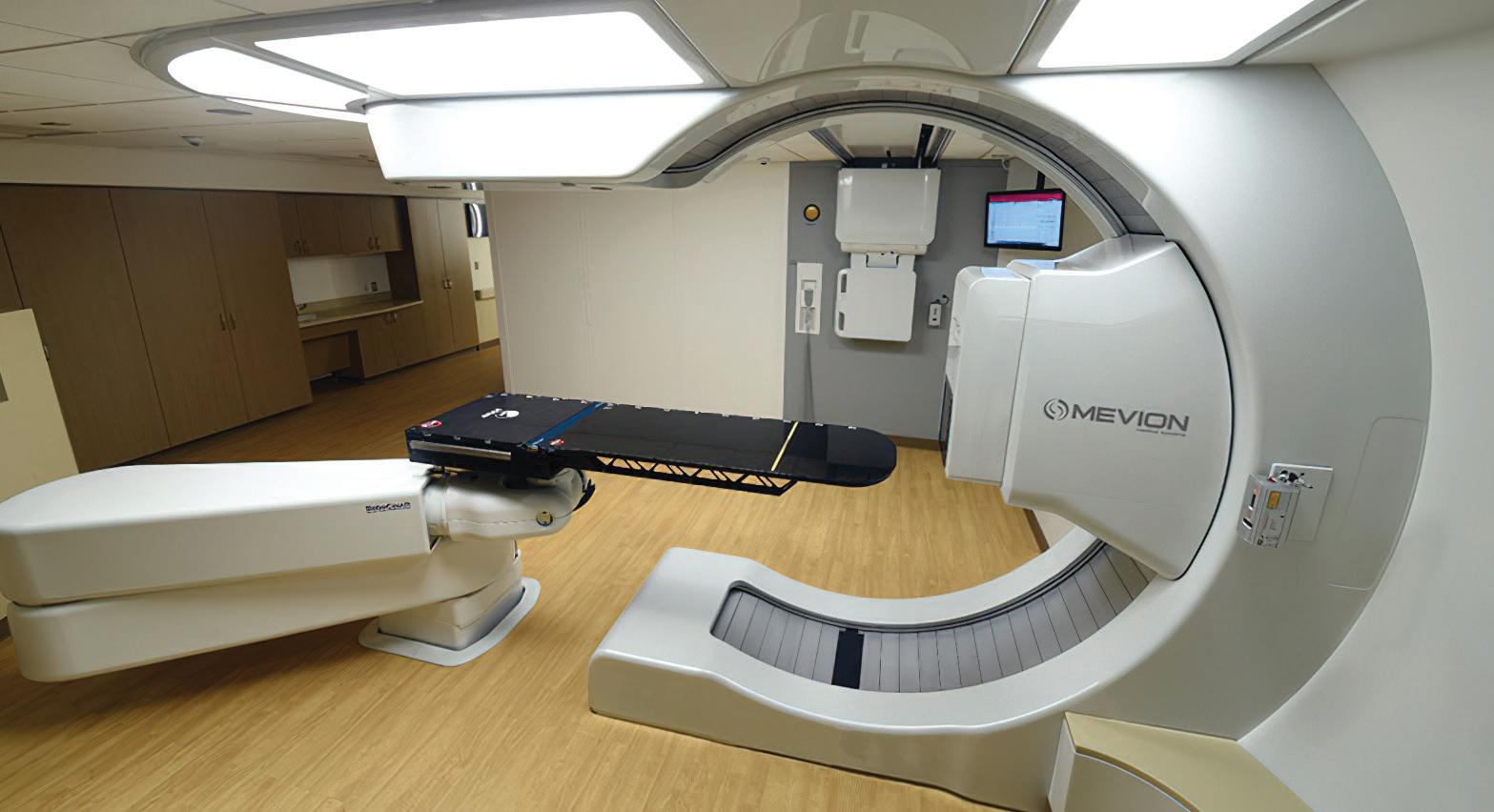
Advanced Radiation Center will be the only location offering proton therapy treatments between Washington, D.C., and Atlanta.
“This technology will add to the Levine Cancer Center’s reputation as a world class cancer institution,’ Prabhu says.
Two hospitals in eastern North Carolina have been expanding their cancer care services and recently consolidated them under one roof.
In New Bern, CarolinaEast Medical Center is now offering cuttingedge cancer treatments at its SECU Comprehensive Cancer Center.
“Our medical oncology practice was located across town from the hospital,” says Dr. Seth Miller, medical director of clinical research and chief of medical staff. “For the last decade, the medical community has been striving to put all cancer services in one location.”
The facility opened in January 2020.
“We are by no means an academic center, but we continue to educate ourselves and stay at the forefront of science,” Miller says. “These efforts contribute to our strong reputation and are a big part of our success.”
Ronnie Sloan, president of Outer Banks Health in Nags Head, recalls a time not so long ago that there was no hospital along the Outer Banks. Patients
There are fewer than 50 units like this in the United States, and when all services are available to patients, the Atrium Health Levine Cancer Proton and Advanced Radiation Center will be the only location offering proton therapy treatments between Washington, D.C., and Atlanta.
The Outer Banks Hospital opened in 2002 but was re-named Outer Banks Health in 2022. The full-service community hospital offers a variety of inpatient and outpatient services. As the Outer Banks population grew, the hospital grew along with it.
“We started with about 150 employees and today have over 500,” Sloan says.
Last January, Outer Banks Health opened the Carol S. and Edward D. Cowell Jr. Cancer Center, a 15,000 square-foot, state-of-the-art facility made possible through the collaboration of Outer Banks Health, ECU Health, Chesapeake Regional Healthcare and support from the Outer Banks community, which raised $6.5 million.
“We do a lot of community outreach including free cancer screenings, giving us the opportunity to connect with our residents and give back,” Sloan says. “We do about 5,000 mammograms a year and about 400 lung screenings, and in a place like the Outer Banks, where there are limited facilities, spending time and effort preventing cancer or catching it early is important.”
Before opening the cancer center, patients had to visit multiple departments all over the hospital and even across the street to receive their treatments. In 2015, the hospital began the process of consolidation and bought land across the street to build the new cancer center.
The facility features 10 infusion areas, four medical oncology exam rooms and two radiation oncology exam rooms.
had to drive to Elizabeth City or Norfolk, Virginia for treatment. The drive often took more than an hour.
“If there was an accident, people were transported all that way in the backs of ambulances, and sometimes even station wagons or whatever else they could find to take them,” says Sloan. “Moms would deliver babies literally on the side of the road when they couldn’t make it to the hospital in time.”
“Just because we’re a small community hospital doesn’t mean we can’t do important work,” Sloan says. ■
— Teri Saylor is a freelance writer in Raleigh.
















From certificates to diplomas, N.C. colleges, universities offer abundant possibilities.
North Carolina has 58 community colleges and 68 four-year institutions, including 16 public universities. Nearly every acre of the state’s 100 counties is within a 30-minute drive of a campus of higher learning, according to the N.C. Community Colleges System.
Course options accommodate students’ individual needs – class combos with a side of financial assistance, employer-paid skill-enhancement, remote and work-based learning, and connections to MBAs and doctorates.
“What’s disappearing from the picture is someone graduating from high school, then getting a job that has a good career attached to it (without further studies),” says Anthony Clarke, president of Guilford Technical Community College, which has six campuses in the Triad. “Our apprentice programs prepare students to work in good-paying technical jobs, and once they start, they can get a bachelor’s degree and go into management or leadership. Once you get in, for the first job on your career path, you can build from there. That first job is not the end; it’s the start.”
Industry needs evolve rapidly, says East Carolina University Chief Innovation and Engagement Officer Sharon Paynter. “While the traditional path to a university still works for many, there are others with drive and the potential who may not have the option of pursuing the standard educational journey,” she says. “Also consider professionals who followed a career path but are now faced with gaps in skills due to advances in technology or processes. The continuing education options ECU offers allow professionals to progress in their expertise and capacity while on the job, offer field-specific upskilling and provide non-traditional pathways to degrees that ultimately strengthens our workforce.”
“In today’s ever-changing job market, advancing skills and education is more critical than ever,” says Pooneh Lari of NC State’s Department of Educational Leadership, Policy and Human Development, and assistant teaching professor and program coordinator for the M.Ed. in Training and Development / Adult & Lifelong Education. “Professionals seeking to



stay competitive and advance their careers must continually update their knowledge and capabilities.”
Scott Ralls, president of Wake Technical Community College, calls it “laddering up,” or ladder economics.
“It’s not how many programs you put out there but how you connect the rungs on that ladder, how you can move up,” he says, “and with us, it’s our fouryear partners. Every one of our degree programs has a four-year partner. You can start in high school, or you can start as an adult. Our programs are stackable, meaning they can lead to different certifications along the way.”
High school graduates and adults returning for personal goals, through employer-financed upskill or for higher certifications and degrees have multiple choices.
Wake Tech’s Propel – free, accelerated Workforce Continuing Education (WCE) courses in biotechnology, business, construction and maintenance, healthcare, hospitality, IT, public safety and
transportation – and WakeWorks, a school-county partnership for technical workers training; NC State’s Continuing and Lifelong Education (NCSCaLE) and ELPHD; Guilford Tech’s FAME (Federation for Advanced Manufacturing Education, a side entity of Toyota) and GAP (Guilford Apprentice Partnership) and others match careers with curriculums.
NC State’s continuing education sector, which marked its 100th anniversary in August, has newly-added artificial intelligence and cyber security paths. Top fields of study include data science, data analytics, human resource management and AI-powered tools like Copilot for Windows, an evolving switch from a decade ago when enrollment leaned toward graphic design and Excel training. The school partners with local manufacturers and others, who enroll employees in non-credit certificate courses.
Industry relevance in adult learning is also noted in master’s courses.
“The upward trend in working professionals enrolling in our training and development master’s program is a testament to the value placed on continuous learning and professional development,” Lari says. “Many professionals recognize that a master’s degree can significantly enhance their career prospects, offering opportunities for advancement and higher salaries.”
The College Foundation of N.C. outlines more than 100 aid and scholarship options.
Its FELS (Forgivable Education Loans for Services) path targets critical employment shortage professions (such as rural-area nurses); N.C. Student Assist Loans bridge the gap between financial aid packages and total costs.
High school grads have the required FAFSA (Free Application for Federal Student Aid), and Next NC, which combines a federal Pell Grant with state-funded financial aid to provide a minimum of $3,000 to any North
Carolina community college and $5,000 to any of the 16 four-year public universities, ba sed on income.
“Ten years ago, 98% of parents wanted their kid to go to a four-year college, then get a job. Now only 50% of parents feel that way,” says Ralls. “Part of the reason is that what we think of as traditional college has become way too expensive. For many students, when they come out, they’re still struggling and unemployed and can’t get that first job.
“We have low tuition, and for many students our growing trend is that they start jobs while they’re going to college. That’s the new norm, especially with programs such as automotive and biopharma.”
food processing, textiles, furniture and distribution.
“There are a lot of opportunities, but you’ve got to sell it,” Clarke says. “This is where you start; this is where you can end up. We continually work with Guilford County Schools, the private schools, the home schools. We can pull in a bunch of things – construction, healthcare, public safety – and there’s the challenge of finding workers across these industries. We can help them, their families and the state. It’s a good thing, overall.”
Wake Tech, North Carolina’s largest community college, serves more than 70,000 adults annually, in addition to incoming freshmen. “Most have some

In the past few years, North Carolina has seen large investments in aerospace and aviation, automotive via Toyota and VinFast, and biotechnology and pharmaceuticals, among others. N.C. Edge is the customized training program that collaborates with the N.C. Community Colleges to help all-size businesses’ employees “master new technologies, keep pace with business trends and unlock their potential,” according to the website, through business-specific training in advanced manufacturing, aerospace, automotive, biotech and pharma, business and financial, IT,
inkling when they come in of what they want to do. We have more than 250 degree programs and 1,000 training programs,” Ralls says. “They may say ‘healthcare,’ but then there’s nursing, or imaging or other healthcare areas. So you have to let them explore. We have Care Teams in 13 different career areas, and a 14th for veterans. Over time, they become aware of the companies that are out there, and we make it as easy as possible to hire Wake Tech students.”
“Our Training and Development department has an advisory board that is composed of expert leaders from different industries in the Triangle who help us keep our master’s program aligned with industry trends,” Lari says.
“Our Master of Education in Training and Development (M.Ed.) program is designed to equip working professionals with the knowledge and skills necessary to lead and innovate in the fields of workforce training and development. Our curriculum covers essential areas such as instructional design, adult learning theories, training delivery methods and evaluation techniques.
“The T&D program offers support to our students in job placement assistance, resume workshops and interview preparation. Our graduates are highly sought after by employers in various sectors including corporate training, higher education, healthcare and government.”
In March, ECU joined with the Institute for Defense and Business for customized continued education and leadership development for military, government and industry leaders. Programs are offered through ECU’s Office of Continuing and Professional
Education and in consultation with ECU’s Office of National Security and Industry Initiatives.
According to EducationNC and Lumina Foundation study data from 2022, 54.4% of working-age adults in North Carolina earned a postsecondary degree or credential, the highest increase being in certificates.
Wake Tech’s ladder economics is the promotion of economic mobility through education and workforce training courses that foster career upgrades and salary gains, such as the climb from certifications and licensures, to an associate degree, to a bachelor’s and master’s or doctorate.
Wake Tech’s laddering “rungs” include: foothold training through Propel, short-term workforce training courses that lead to industry certifications; aligned dual enrollment, a Career and College Promise path

for high school students; stackable credentials, which give specific training in larger categories such as a commercial wiring certificate with an electrical systems technology degree; work-based learning, for degree credit through on-the-job experience and WakeWorks apprenticeships; strategic workforce transfer, through pairings with four-year schools in the UNC System; and degree-plus skills, advanced training in fields such as biotechnology and IT.
In Winterville, Pitt Community College’s welding program, the largest in the state, soon will be housed in a 30,000-square-foot facility, to be completed in 2025. The building will have 96 welding booths and space for robotic instruction, says John Carrere, director of the office of recruitment and first-year experience at PCC.
Pitt is the eighth-largest community college in the state, with 18,000 curriculum and continuing ed students in 2022–23.
In July, Guilford Tech announced groundbreaking in 2025 on a $55.8 million, 100,000-square-foot aviation training center at its Cameron Campus near Piedmont Triad International Airport, with Phase 1 opening in January 2027. “We’re in the design phase right now. It will allow us to consolidate all our aviation training in one location,” Clarke says, “and focus more on providing for the aviation partnerships.”
The college works with Boom Supersonic at PTI, and with Marshall and C-130s for the military, Honda Aircraft, HAECO and FedEx. “We have more than 400 students and we’re looking to expand to over 600. We’re a key partner with PTI, and they do rely on us to provide the right skills they’re looking for.”
Guilford Tech started its Toyotasupported FAME avenue in August 2023. “When Toyota opens a plant, FAME comes along. When they opened in Kentucky (the assembly




plant in Georgetown), they had a FAME,” he says. “We have about 13 students who are apprentices, or FAME students, going into their second year, and we have 29 more who are starting their first year in this advanced manufacturing technology apprenticeship program.”
The college’s GAP program lets students work paid apprenticeships for local companies. They’re paid for on-the-job time as well as time spent
in class. “It started as manufacturingbased, with different companies in the Triad, and it’s expanded to include HVAC, accounting, IT,” Clarke says. “We’re bringing in about 50 new apprenticeships in GAP.”
ECU’s Eastern Region Pharma Center in its Life Sciences and Biotechnology building, which opened in 2021, is supported through Golden Leaf and partners with 15 pharmaceutical companies in workforce development.
Appalachian State University in Boone: The university has more than 150 degree programs, 80 graduate programs, 36 graduate certificates and two doctoral programs (psychology and education). Its Cratis D. Williams School of Graduate studies’ enrollment tops 2,000.
Campbell University in Buies Creek: The private Christian university in Harnett County, north of Fayetteville, has online certificate programs, eight different eight-week accelerated associate degrees, 23 bachelor programs and two master’s programs. Most are available online and at its Camp Lejeune and Fort Liberty campuses (military discount available.)
Catawba College in Salisbury: The school has an 11-1 student-to-faculty ratio, average class size of 13 and more than 70 academic programs. Students in each program can participate in


micro-internships in which businesses hire personnel to meet short-term project needs or alleviate staff shortages. The college’s career database uses Handshake, a platform to connect with careers, internships and businesses.
Central Piedmont Community College in Charlotte: In partnership with Ed2Go, CPCC has online open enrollment programs to help students acquire skills for professional level positions in nine fields, including computer science, information technology and teacher professional development.
ECU in Greenville: Bestcolleges.com notes that ECU has 69 master’s programs. STEM programs are the most in-demand. ECU is an educational partner with the N.C. Economic Development Association, with a certification program for developers, elected officials, business leaders and others. Its School of Dental Medicine has state-of-the-art learning halls,
simulation labs, patient clinics, clinical research areas, and faculty and administrative offices.
Fayetteville State University: The college has 12 online degree programs, and 50% of students are age 24 or older. Its four main areas are business and economics; education; health, science and technology; and humanities and social sciences. FSU offers Military Tuition Assistance.
N.C. A&T State University in Greensboro: Selected as the nation’s No. 1 public HBCU in 2019 by U.S. News & World Report, the school offers 58 undergraduate degree programs, 18 minors, 13 doctoral degrees, 36 master’s and 41 graduate certificates.
NC State University in Raleigh: NCSCaLE’s customized training caters to a range of employers such as recent collaborations with Hitachi Energy, a project management program for the town of Cary and a leadership
program for DHHS. ELPHD credentials include master of education or master of science in adult and community college education, graduate certificate program in teaching, training and educational technology and a Ph.D. in educational leadership, policy and human development with specialization in adult and lifelong education.
Pitt Community College in Winterville: “Pitt Community College awards associate degrees, diplomas and certificates in more than 80 programs of study,” Carrere says. “It also provides adult basic education and literacy training, English Language Acquisition courses, small business assistance, customized training for business and industry, workforce development classes and personal enrichment courses. Combined, PCC offers more than 280 credentials through curriculum and continuing education programming.”
Graduates from the University Transfer programs who receive an
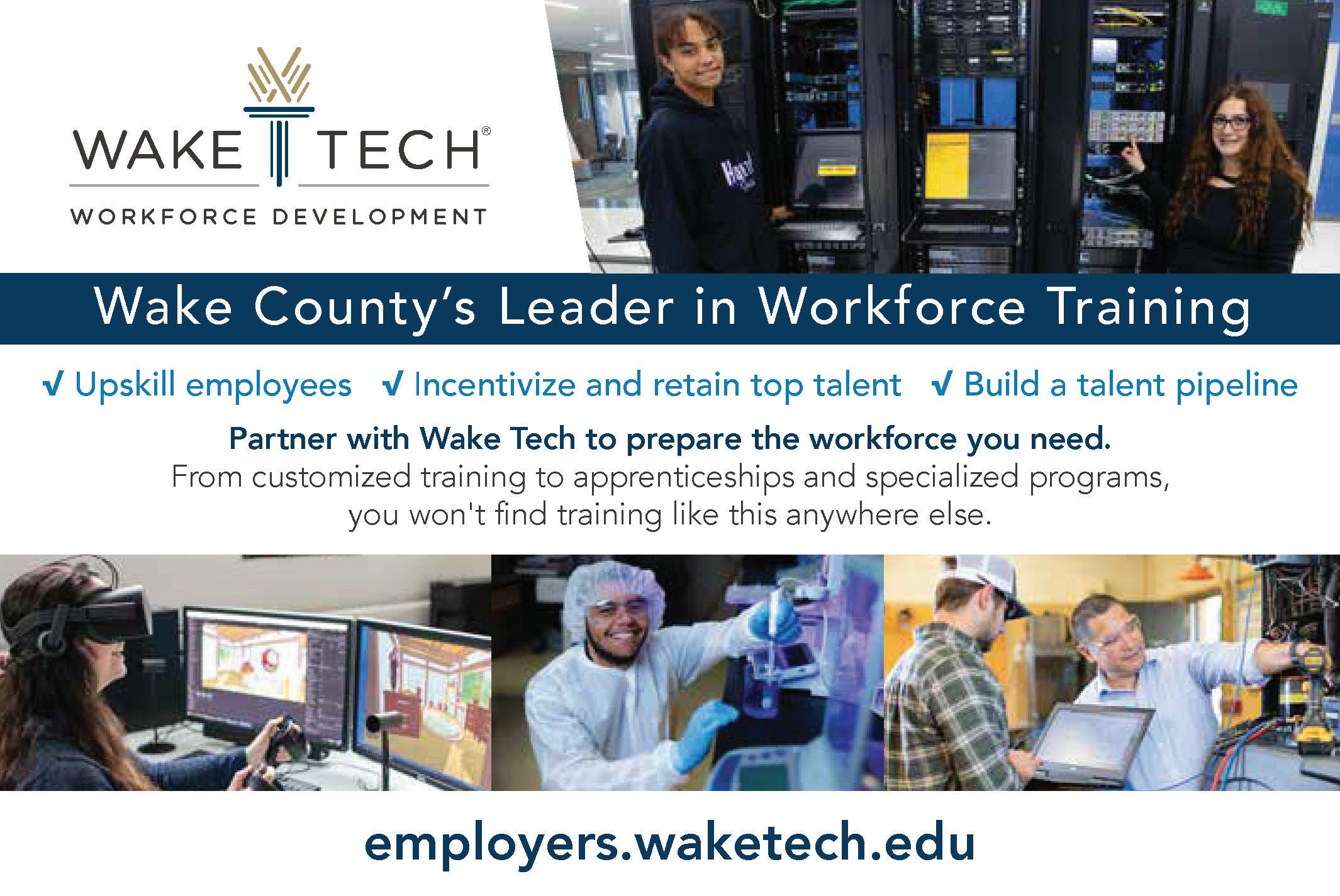
associate’s degree in arts, science or engineering are eligible to enroll in any four-year university to add a bachelor’s degree. Pitt has “additional programtransfer agreements with colleges such as Fayetteville State, Elizabeth City State, ECU, and N.C. A&T,” Carrere says.
“Our associate of applied science degree in biotechnology prepares students for work as laboratory technicians and allows students to save time and money if they are interested in completing a two-year associate degree in biotechnology,” Carrere says. “Our continuing education program offers a BioWorks certificate that can be completed in one semester. Our cosmetology program offers preparation for licensure in just one year, and we offer real estate pre- and post-licensure classes in online, hybrid and remote format, as well as auto dealer licensing preparation programs.”
UNC Wilmington: For the eighthconsecutive year, UNCW is mentioned in Fiske Guide to Colleges , which notes UNCW’s “strong programs, including marine biology, chemistry, ecology, film studies, creative writing, nursing, business administration and communication studies,” according to the college website. Its CSURF (Center for the Support of Undergraduate Research and Fellowships) supports “advising, providing funding, supporting travel to conferences, programming and more” to help students seeking national and international fellowships.
“Getting an associate’s degree and a high-paying job can lead to a great career,” Clarke says. “But you have to have the mindset that it’s sort of a new start. You don’t get your degree and you’re done. It’s the start of your career, and you can build from there.”
“It’s important to see the ladder going up,” says Ralls, “and you can go as high as you want to. You can always see the next rung, and the next rung is always reachable.” ■
— Kathy Blake is a writer from eastern North Carolina.

Putting N.C.’s higher education system to work.
High school students, and adults wanting to further their education, have numerous options in North Carolina’s community colleges and universities, paper trails of certificates and diplomas for industry specific training, executive education, bachelor’s and MBAs, many available in-person and online.
“It’s really about connecting programs vertically for career mobility,” says Wake Technical Community College President Scott Ralls. “There’s a place for everyone to start.”
Some examples:
Bhushan Desai is executive director of operations at Eli Lilly in the Research Triangle Park. He immigrated from India in 2006, enrolled in Wake Tech that fall and graduated in 2008 with an associate of science degree.

“The institution was crucial not only for my academic growth but also for providing stability as an 18-year-old navigating a new country,” he says. “Wake Tech also offered me the opportunity to apply for and be selected for the Carolina Student Transfer Excellence Program.”
C-STEP partners with 14 N.C. community colleges, focuses on associates of arts and associates of science degrees and has GPA requirements.
Desai started classes at UNC Chapel Hill in 2008 and graduated in 2010 with a degree in biochemistry. At Wake Tech, he had multiple jobs and served as public information officer for the Student Government Association.
“The ladder of educational opportunities provided a solid foundation for my personal and professional growth. The academic curriculum at college equipped me with a robust understanding of my field, essential for tackling complex problems in my career,” he says.
A Brookings Institute report notes that between 2020 and 2022, life sciences companies committed to invest $9.1 billion and create 12,500 jobs across N.C., many in biopharmaceutical manufacturing.
Desai has advice for those considering that career path.
“Embrace curiosity and explore. This industry beautifully blends science, business and exceptional people,” he says. “We have the chance to work toward a common goal that profoundly changes lives for the better — an immensely rewarding endeavor. Additionally, this field offers a wide array of career opportunities, including technical roles, quality assurance, quality control, engineering, human resources and manufacturing operations.”
Derek Williams knows about stackable credentials.
He graduated from Duke University in 2011 with a degree in sociology and certificate in markets and management studies. He then earned two business analytics certificates, in marketing analytics and business intelligence, from Wake Tech while simultaneously working at the Rural Economic Development Center as a program manager and overseeing a $2.1 million micro-loan fund. His employer paid for several classes in the business analytics program.

He returned to school at UNC’s Kenan-Flager Business School and graduated in 2018 with an MBA in management consulting and entrepreneurship while interning at Triangle Angel Partners and a venture capital fund in Durham, IDEA Fund Partners.
“While working at the Rural Center, I knew I wanted more of a business background,” he says. “I was interested in data and learning how to properly dig into it to identify trends and the story within the data. It would be a useful skill to me while managing a loan portfolio of small business loans. This led me to taking the Wake Tech business analytics classes. After completing those classes and a couple of more years at the Rural Center, I kept moving forward to pursue my MBA.”
His words to prospective students: “If you can combine technical skills with your academic knowledge or learn new skills that will supplement your practical work experience, you’ll greatly benefit.
“New, refined skills add to your value as an employee, or business owner, and enhance your ability to understand multiple areas of industry, general business and the broader economy. Take advantage of evening and weekend programs at the community college, or those sponsored by your employer. Simply put, enhance your value and make sure employers, or clients, will need and want you working for them.”
Jaylon Martin graduated from Fuquay-Varina High School and started at Wake Tech in 2020, majoring in mechanical engineering technology. His degree allowed him to transfer to East Carolina University’s industrial technology program and, in 2022, using online and in-person classes at Wake Tech’s Raleigh campus, he became Wake Tech’s first student to receive a bachelor’s degree in industrial technology from ECU. His employer, RoviSys, provided tuition assistance.

“I didn’t want to have to commute to Greenville or to move there,” Martin says. “It worked out perfectly with ECU.”
Martin’s career ladder has one more rung. He’s been accepted into ECU’s master’s program and hopes to advance with RoviSys.
“I’m looking to grow within that company,” he says. ■
— Kathy Blake is a writer from eastern North Carolina.





A Paris trip underscores the state’s interest in attracting Olympic sports activity.
BY RAY GRONBERG
Some well-connected North Carolinians want the state to eventually host the Summer Olympics, prompting major public investment to spur interest in the sports groups that decide who represents the U.S. at the quadrennial event.
State lawmakers in 2021 allocated $25 million to the Charlotte-based U.S. Performance Center, while an affiliated group, the N.C. Sports Legacy Foundation, received $30 million in 2023. The little-known groups are led by Charlotteans Ike Belk and David Koerner, who started the Performance Center a decade ago to promote amateur sports and attract national groups to set up North Carolina operations. Belk’s grandfather, department store chain heir Ike Belk, was an U.S. Olympic Committee member and major donor for athletic facilities.


Learning about how Olympic sports groups work was a key purpose for a June 25-29 trip to the Paris games by N.C Senate leader Phil Berger, four other state senators and Rep. Kyle Hall. The nonprofit 501(c) (4) Opportunity for North Carolina paid for the trip, according to Woody White, a Wilmington lawyer who chairs the group. He is a Senateappointed member of the UNC System Board of Governors.
NORTH CAROLINA MEDALISTS FROM THE 2024 PARIS OLYMPICS
Kaylyn Brown, track, one gold, one silver
Cierra Burdick, basketball, bronze
Anna Cockrell, track, silver
Quanera Hayes, track, gold
Evy Leibfarth, canoeing, bronze
Sammy Sullivan, rugby, bronze

Source: Newsweek
The Performance Center has spent $45.5 million of the $55 million as of June, The Assembly website reported in early August. While state funds were intended for capital needs, only about $10 million has paid for facilities or equipment. About $7 million went for a field hockey pitch at UNC Charlotte, which was built by Pembroke-based construction firm Metcon. Its owner, Aaron Thomas, is among the state’s most politically active business leaders.
Otherwise, the Performance Center spent $9.8 million on its own consulting services; $4.5 million to outside consultants including Seneca Jacobs, Marion Waters and Marty McCarthy; and $2.9 million in personnel costs, including $800,000 in salaries for Belk and Koerner over two years, the Assembly reported. Other money went to support various U.S. Olympic sports programs, none of which have relocated to North Carolina. Because of such spending, the Office of State Budget and Management’s internal auditors are reviewing the center and legacy foundation, the News & Observer reported.
Berger and other policymakers have supported efforts to recruit such events as the U.S. Open golf tournament in Pinehurst. Recently, there’s been talk of seeking a Major League Baseball team in Raleigh, potentially led by Carolina Hurricanes owner Tom Dundon. This summer, former Berger Chief of Staff Brian Fork was named CEO of the NHL team’s business unit.
“There have been discussions of beginning to make long-term plans to try to recruit the Olympics to North Carolina at some point in the future,” White says.
Others making the trip with Berger and Hall were Sens. Bill Rabon, David Craven, Michael Lee and Danny Britt. Knowing such trips can raise eyebrows, White provided details on the itinerary and the travelers’ relatively modest Paris hotel. Rooms at the Victoria Palace Hotel typically fetch about $180 to $240 per night, an Internet search shows.
White said the U.S. Performance Center did not fund the trip but played a role. The nonprofit has developed “the industry relationships to connect policymakers with Olympics organizers in Paris,” White says.
The group’s objectives include a “desire to attract major sporting events to North Carolina,” he says. The Olympics offered a chance to learn “about the infrastructure, security and other foundational undertakings required for a major sporting event at scale.”
The State Ethics Commission suggested that White’s group “eliminate any USPC influence over the trip,” he adds. As a result, the group is reimbursing the Performance Center for expenses and took control of the itinerary. No lobbyist contributions to the 501(c)(4) group are paid for the educational trip, White says.
Hosting rights for the Summer Olympics are locked up through 2032, with games set for Los Angeles in 2028 and Brisbane, Australia in 2032. Discussions are underway about 2036, with Indonesia, Turkey, India and Chile known to be showing interest. ■
SUMMER OLYMPIC HOST CITIES: 2008 - Bejing | 2012 - London | 2016 - Rio | 2020 - Tokyo | 2024 - Paris | 2028 - Los Angeles | 2032 - Brisbane, Australia

